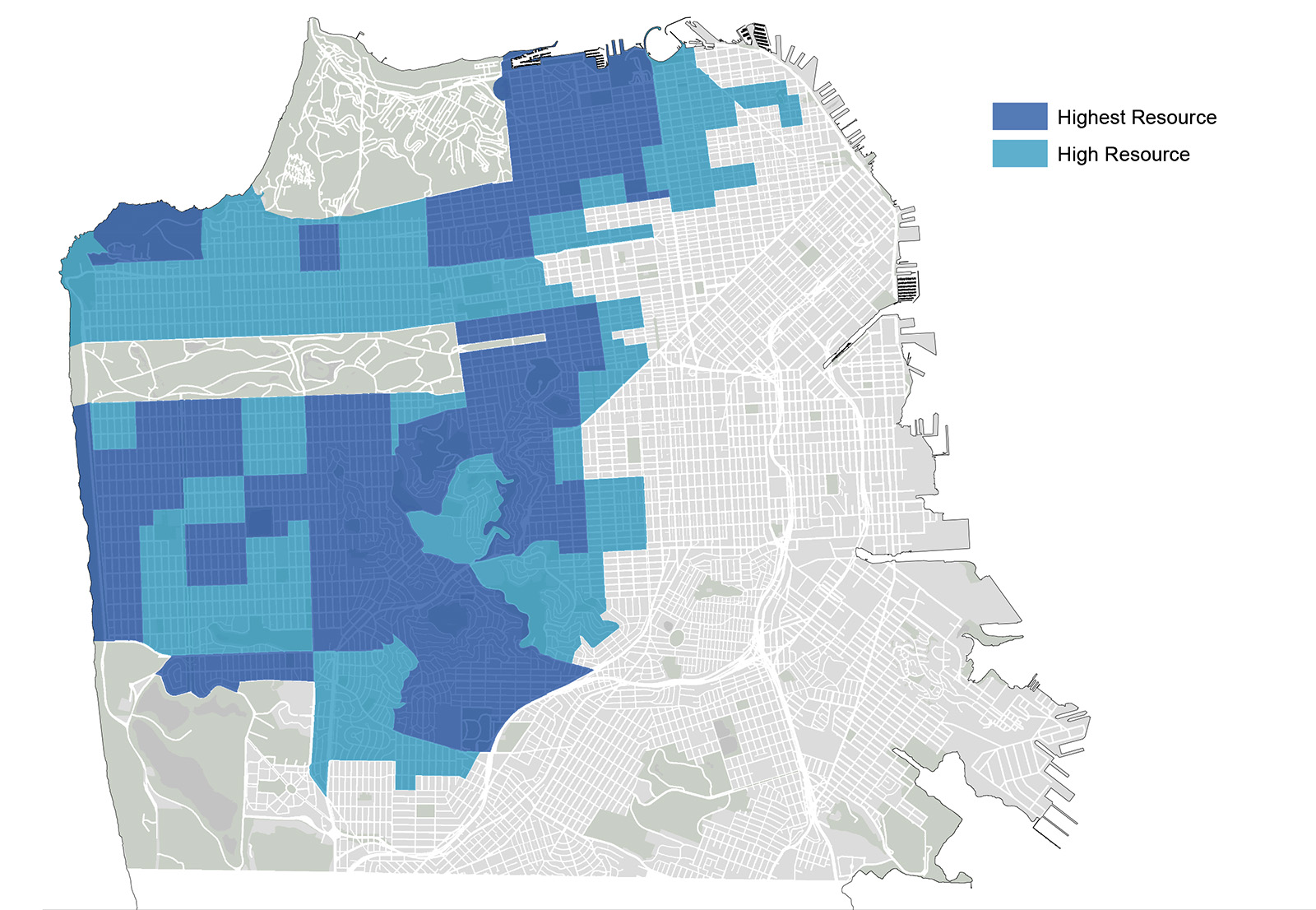Housing Element
NOTE: This 2022 Housing Element was adopted by the San Francisco Board of Supervisors on January 31, 2023. This update replaces the previous 2014 Housing Element. The following text includes the Goals, Objectives, Policies and Implementing Programs of the Housing Element. All the required and adopted analysis documents related to the 2022 Housing Element Update are available separately here.
INTRODUCTION
Purpose
The Housing Element serves as San Francisco’s roadmap for meeting the housing needs of all its residents. It is one component of the city’s broader general plan, which also includes other elements on transportation, community safety, and open space. California expects all cities and counties to maintain a current general plan and specifically requires an update their housing element every eight years.
The Housing Element Law mandates that local governments must adopt plans and regulatory systems that provide opportunities for, and do not unduly constrain, private market housing development. As a result, housing policy in California rests largely on the effective implementation of local general plans and, in particular, housing elements. Additionally, the California legislature passed Assembly Bill 686 Affirmatively Furthering Fair Housing (AFFH) in April 2020, a new law which builds upon existing fair housing protections to require housing elements include policies to combat patterns of segregation to foster more inclusive communities. All housing elements must ultimately be adopted by each municipality’s local government and approved by the California Department of Housing and Community Development (HCD).
To fulfill these mandates, the Housing Element 2022 Update (2022 Update) is San Francisco’s first housing plan that is centered on racial and social equity. It includes policies and programs that express our city’s collective vision and values for the future of housing in San Francisco. The 2022 Update articulates San Francisco’s commitment to recognizing housing as a right, increasing housing affordability for low-income households and communities of color, opening small and mid-rise multifamily buildings across all neighborhoods, and connecting housing to neighborhood services like transportation, education, and economic opportunity.
Regional Housing Needs Allocation
California Housing Element Law requires that housing elements accommodate and prepare for the creation of enough housing to meet each region’s specific housing target, called its Regional Housing Needs Allocation (RHNA). This target was set by the Association of Bay Area Governments (ABAG), a regional planning agency, and approved by the California Department of Housing and Community Development (HCD) for San Francisco. This assessment is based on San Francisco’s unmet housing need at every income level and projected population growth. San Francisco’s 2023-2031 RHNA mandates the creation of more than 82,000 units within the city, broken down into targets by income group.
The 2022 Update is both a policy framework and an actionable plan. While this document does not immediately alter land use or housing programs, it facilitates action by identifying priorities for decision makers, guiding resource allocation for housing programs and services, and defining how and where the city should create new homes for existing and future residents.
The main portion of the Housing Element contains the Housing Goals, Objectives, and Policies outlining the values and priorities for the 2022 Update, following by the Housing Implementation Plan that details actions to achieve the goals set forth. These goals and actions are supported by public input and analysis attached in the appendices – the Public Input Summary, Housing Needs Assessment and Fair Housing Assessment, Sites Inventory and Rezoning Program, Analysis of Governmental and Non-Governmental Constraints on Housing, General Plan Consistency, and 2014 Housing Element Evaluation.
Approach
This update is the result of a multi-year, cooperative, public, and interagency planning process that began in 2019. As a result, its goals and actions cut across agencies and are consistent with broader goals identified in the San Francisco General Plan. The drafting of 2022 Update relied extensively on outreach and engagement to communities historically underrepresented including low-income communities of color and vulnerable groups. Three phases of outreach and engagement, over the course of two years, inform the 2022 Update. For the first time at this scale, the Department funded and supported focus groups led or co-hosted by community-based organizations representing American Indian, Black, Latino, Chinese, Japanese, Filipino, low- and moderate-income households, seniors, people with disabilities, LGBTQ+ and transgender, and homeless advocates. Outreach and engagement also included housing policy experts, advocates, affordable housing developers, labor organizations, architects, and developers.
Reader’s Guide
The housing element is organized as follows:
Goal and underlying Objectives listed with brief framework narratives
Policies listed with corresponding Objectives and related programs
Implementing Programs listed with related Policies, responsible agencies, and timeframe for action
Quantified Objectives Table listed with expected number of housing units or people served for each Implementing Program
Affirmatively Furthering Fair Housing (AFFH) Actions Table listed with metrics for monitoring progress
Census data cited in the goal and objective narratives have been updated since its last release in January 2022. This new data reflects population definitions based on conversations with the American Indian community. Data from other sources, such as the Mayor’s Office of Housing and Community Development and Department of Homelessness and Supportive Housing, however, were not able to be updated along this new definition.
Technical supporting analyses and public input summaries are organized in the appendices.
A glossary of terms is provided in Appendix G at the end of this document as a reference.
The following is a list of acronyms used to identify the agencies responsible for each Housing Element action:
City Agency Acronyms
APD Adult Probation Department
ARTS Arts Commission
BOS Board of Supervisors
DAS Department of Disability and Aging Services
DBI Department of Building Inspection
DPH Department of Public Health
DPW Department of Public Works
DSW Department on Status of Women
DCYF Department of Children, Youth and Their Families
HSA Human Services Agency
HRC Human Rights Commission
HSH Department of Homelessness and Supportive Housing
LIB San Francisco Public Library
Mayor Mayor’s Office
MOD Mayor’s Office on Disability
MOHCD Mayor’s Office of Housing and Community Development
OCII Office of Community Investment and Infrastructure
OEWD Office of Economic and Workforce Development
ORE Office of Racial Equity
ORCP Office of Resilience and Capital Planning
OSB Office of Small Business
Planning San Francisco Planning Department
SF Port Port of San Francisco
SFCTA San Francisco County Transportation Authority
SFFD Fire Department
SFHA San Francisco Housing Authority
SFMTA San Francisco Municipal Transportation Agency
SFPUC San Francisco Public Utilities Commission
SFRPD San Francisco Recreation and Parks Department
GOALS & OBJECTIVES
Goal 1. Recognize the right to housing as a foundation for health, and social and economic well-being.
Challenge - Access to safe and affordable housing is a social determinant of health. Several studies have found that housing instability contributes to children and youth being more vulnerable to mental health problems – including developmental delays, poor cognitive outcomes,1 and depression2 - and inferior educational opportunities.3 This trauma can compound to impact health, education, and employment outcomes that can affect people throughout their lives and their descendants’ lives. The racial and social disparities associated with housing instability are well documented and include rent burden (paying more than 30% of their income on rent), homelessness, overcrowded living (more than one person per room, including the living room), and health conditions (see Figure 1).
The COVID-19 pandemic further exposed longstanding racial disparities. Communities of color have endured higher infection and death rates partially due to poor living conditions (such as overcrowding) and poor health conditions.
Path Forward - The United Nations (UN) defines the right to adequate housing as “the right to live somewhere in security, peace and dignity.” The UN sees the right to adequate housing as enacting policies, strategies, and programs that “are needed to prevent homelessness, prohibit forced evictions, address discrimination, focus on the most vulnerable and marginalized groups, ensure security of tenure to all, and guarantee that everyone’s housing is adequate.”4 For the first time, San Francisco is formally recognizing the right to housing. By doing this, the City is making a commitment to offer housing solutions that are healthy and dignified to vulnerable households: those who are unhoused, poorly housed, have been subject to discrimination, or are exposed to instability or inequities due to disabilities, disorders, criminal records, traumas, immigration status, tenure, income, sexual orientation, gender identity, or race.
In response to the current COVID-19 health crisis, the City prioritized housing and shelter for our unhoused populations embracing the connection between housing and health. A commitment to the right to housing will direct the City to scale up its resources in the long-term to offer these equitable outcomes through series of investments and prioritizations. Achieving this goal will mean eliminating homelessness, ensuring housing stability and reversing inequities in housing access for those who are vulnerable.
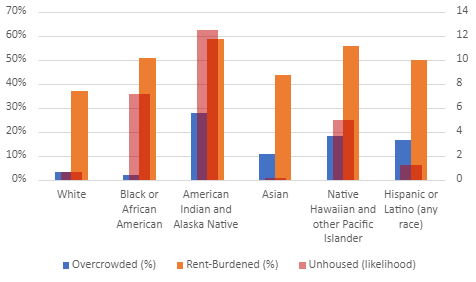
Figure 1. Overcrowding, Housing Rent Burden, and Homelessness by Race (San Francisco).
Source: ACS 2019 1-year Estimates; 2019 San Francisco Point-In-Time Homeless Count and Survey Report, Department of Homeless and Supportive Housing.
OBJECTIVE 1.A
Ensure housing stability and healthy homes
Policy 1 Policy 2 Policy 3 Policy 9 Policy 39
Challenge - Around two thirds of San Francisco’s households are renters. The majority of San Francisco’s rental housing stock is subject to the Rent Control Ordinance, which limits annual rent increases and includes eviction protections. Rent control, however, has been critical but insufficient to fully protect low-and moderate-income residents, as well as American Indian, Black, and other people of color from being at risk of eviction or displacement (see Figure 2). Evictions and displacement increased during recent economic booms during which time rental prices in San Francisco rose to among the highest in the country. The increase in rental prices far outpaced wage growth for low- and moderate-income renters. Now over 80% of very low-income renter households in San Francisco are rent burdened (paying more than 30% of their income on rent). More low- and moderate-income renters are severely cost burdened (paying more than 50% of their income on rent) today compared to 1990 (see Figure 3). Over the past two decades, the city has more households in the low-income category than any other income group (see Figure 4). A survey of around 3,200 renters indicated that about one third would have no housing choice if displaced from their current residence, and another third would have to leave San Francisco to find housing (see Figure 5).
Path Forward - Recognizing a right to housing must start ensuring housing stability for tenants, especially those with limited housing choices and who experience racial and social disparities. San Francisco will expand investment in rental assistance programs as a strong form of protection against housing instability, especially for low-income tenants. These programs have proven critical in preventing evictions during the recent pandemic and have received increased funding at the federal level. San Francisco continues to maintain some of the strongest eviction protections in the region and the country. For effective implementation of these protections, San Francisco passed an ordinance to create a new rental housing inventory. Implementing this inventory will allow proactive enforcement and monitoring of our already strong protection measures, such as regulations controlling Owner Move-Ins or Ellis Act Evictions. Full implementation will also inform a series of new improvements to these protections. The City will also focus on minimizing the abuse of temporary and nuisance related evictions. Ensuring housing stability also relies on preserving affordability of existing units with deed restrictions. The City’s acquisition and rehabilitation programs have been in effect in the past decade and will need to be revamped to ensure the investments are effective and reach those who have been underserved. A renewed interest and focus on co-operative housing will offer expanded opportunities, whether through protections of existing cooperative housing or creating new shared equity and cooperative ownership models.
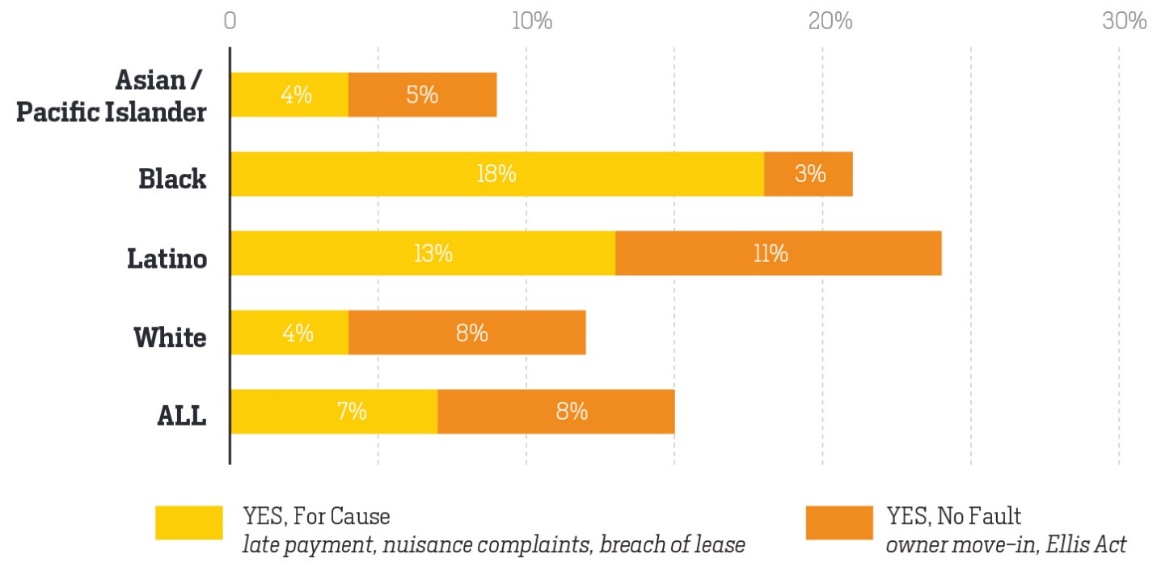
Figure 2. Percentage of the 2018 San Francisco Housing Survey respondents who reported being threatened with an eviction in the previous 5 years by race.
Source: ACS 2019 1-year Estimates; 2019 San Francisco Point-In-Time Homeless Count and Survey Report, Department of Homeless and Supportive Housing.
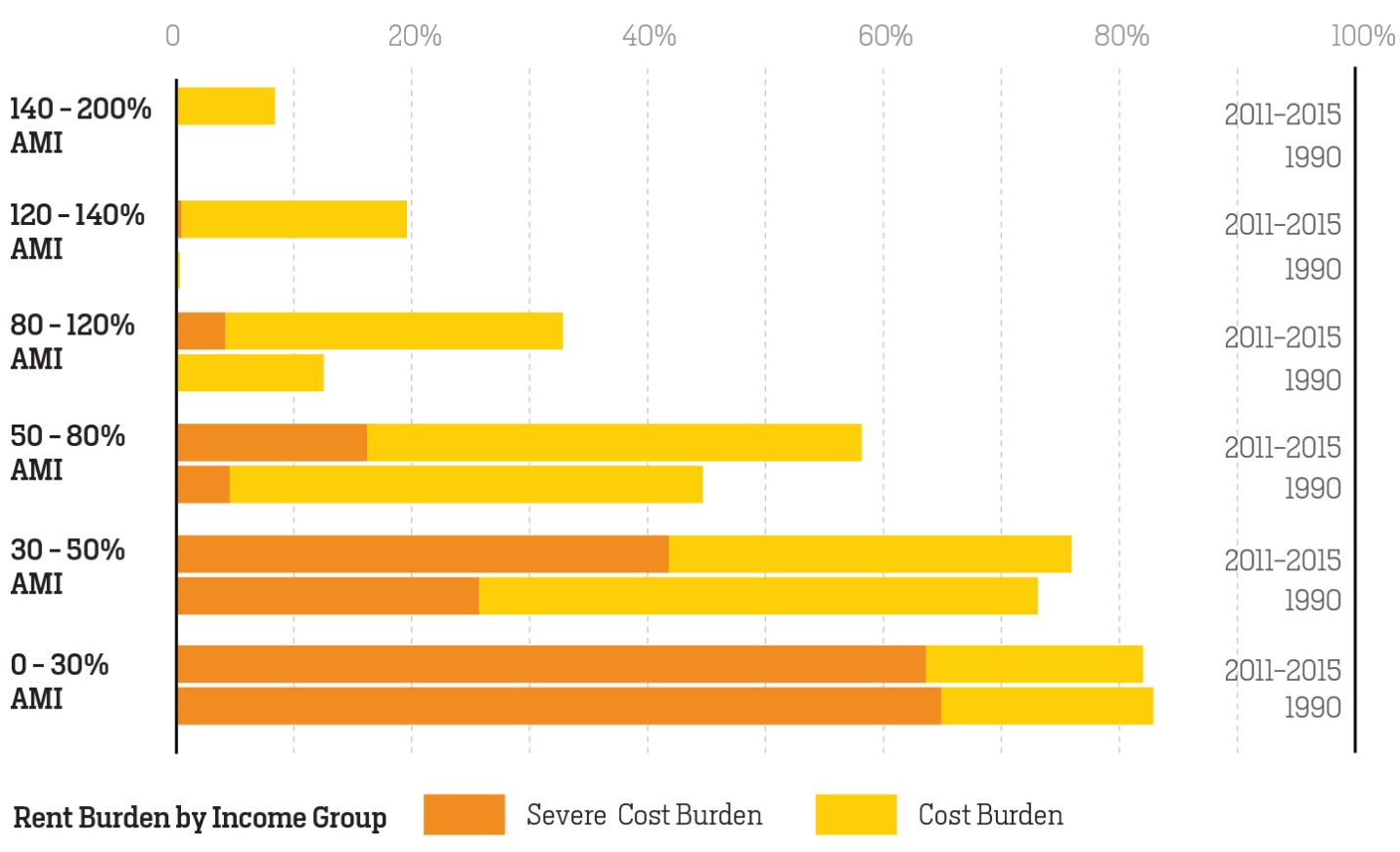
Figure 3. Percentage of San Francisco households that were rent burdened* by income group (1990 vs 2015).
Source: San Francisco Housing Needs and Trends Report; 1990 Decennial Census (IPUMS-USA); ACS 2015 5-year Estimates IPUMS-USA).
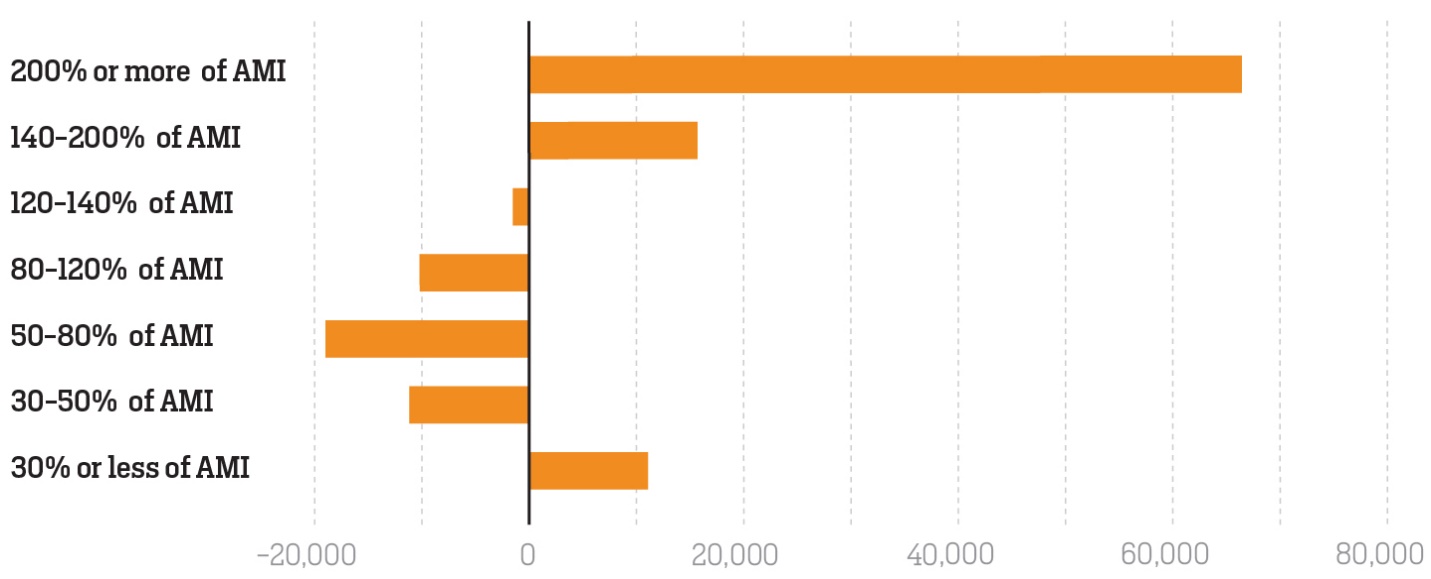
Figure 4. Change in the number of households by household income group from 1990 to 2015.
Area median income (AMI) is a normalized measure of income in a geography. 100% AMI is the median income for SF.
Source: San Francisco Housing Needs and Trends Report; 1990 Decennial Census (IPUMS-USA); ACS 2015 5-year Estimates IPUMS-USA).

Figure 5. Housing choices for 2018 San Francisco Housing Survey respondents if forced out of their current residence by income group.
Area median income (AMI) is a normalized measure of income in a geography. 100% AMI is the median income for SF.
Source: San Francisco Housing Needs and Trends Report; San Francisco Planning Department 2018 Housing Survey.
OBJECTIVE 1.B
Advance equitable housing access
Policy 1 Policy 2 Policy 3 Policy 5 Policy 6 Policy 7 Policy 9 Policy 27
Challenge - Federal fair housing laws prohibit discrimination based on race, ability, sexual orientation, gender identity, and household type. Despite these laws, racial and social disparities in housing access are stark. A major hurdle to housing equity is housing cost. More than half of Black households are rent burdened (paying more than 30% of their income on rent), and households of color overall are more likely to be rent burdened compared to white households (see Figure 6). The American Indian population is 17 times more likely to be homeless compared to their share of population, and Black households are seven times more likely (see Figure 7). The transgender and gender non-conforming (TGNC) community in San Francisco faces specific, heightened, and disproportionate challenges in accessing fair housing opportunities. Half of respondents to the US Transgender Survey report having experienced homelessness in their lifetime, and approximately fifty percent (50%) of transitional aged youth experiencing homelessness in the 2019 point in time count identified as LGBTQ+. Seventy percent (70%) of transgender people living in shelters nationally have reported being harassed,5 contributing to the 24% of homeless transgender people in California that have reported avoiding in staying in a shelter for fear of mistreatment.6 Seniors and transitional aged youth (between the ages of 18 to 24) collectively made up more than half of the homeless population in 2019 (see Figure 8). Seventy-four percent (74%) of respondents of the 2019 Point-In-Time Homeless Count and Survey7 reported living with chronic physical illnesses, physical disabilities, chronic substance use, and severe mental health conditions (see Figure 9). Amongst tenants, renters of color continue to be disproportionately affected by evictions in San Francisco. In a survey of around 3,200 renters, 24% of Latino/e/x renters and 21% of Black renters reported being threatened with eviction as opposed to only 9% of white renters (see Figure 2). While Black, American Indian, and other people of color would most benefit from greater affordable housing access, federal regulations, and California Proposition 209, which bans institutions from affirmative action based on race, sex, or ethnicity, pose a challenge to the City to implement preference programs for the communities of color most affected by homelessness, eviction and displacement, such as the American Indian, Black, and Latino(a,e) communities.
Path Forward - San Francisco has adopted various strategies including programs designed to ensure access for historically disadvantaged or currently vulnerable households in awarding below market rate units. These programs include the Displaced Tenant Housing Preference Program, Neighborhood Preference Program, and the Certificate of Preference Program. To effectively advance equity, the City will revise existing and implement other programs to improve access to permanently affordable housing for underserved racial and social groups. The City will identify clearer strategies to remove barriers to housing access for transgender, LGBTQ+, seniors, people with disabilities, formerly incarcerated individuals, and other specific vulnerable populations, to inform and strengthen current and new programs.
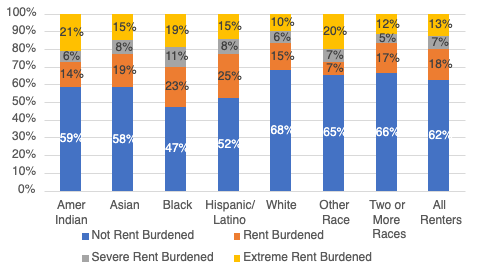
Figure 6. Percentage of households that are rent burdened* by race and ethnicity (2018).
*Rent burden means paying between 30% and 50% of the household’s income in rent; severe cost burden means paying more that 50% of the household’s income in rent.
Source: ACS 2018 5 Year Estimates (IPUMS-USA).
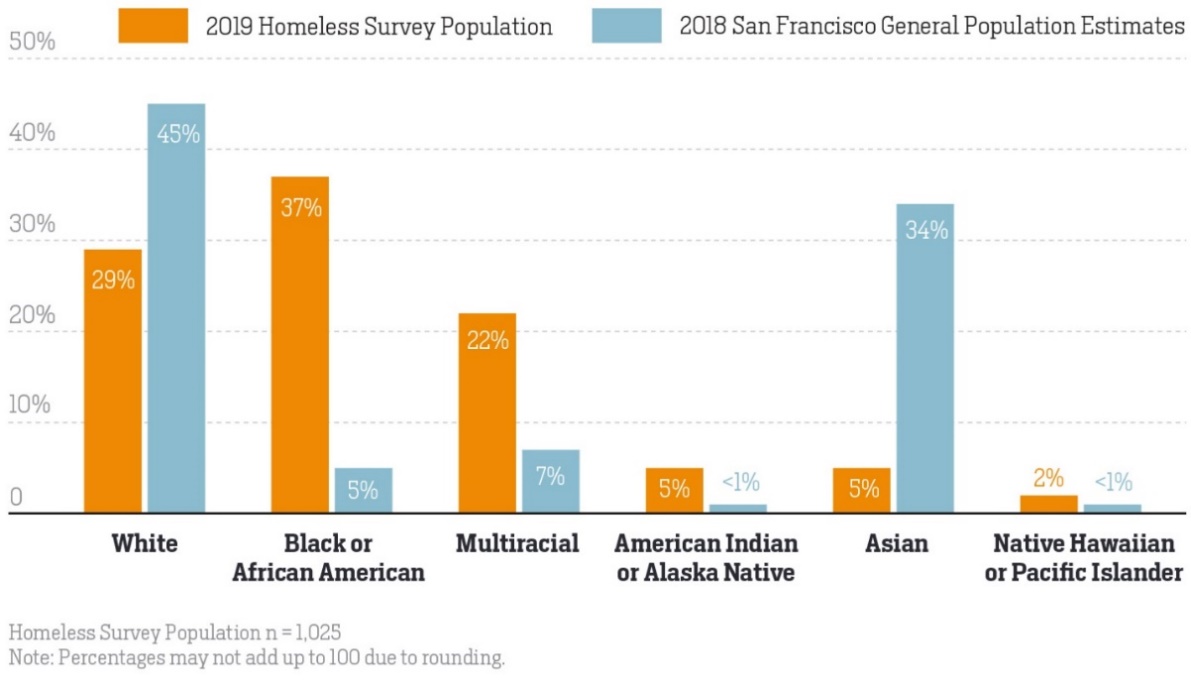
Figure 7. Percentage of people experiencing homelessness by race and ethnicity (2019).
Source: San Francisco 2019 Point-In-Time Homeless Count and Survey Report, Department of Homeless and Supportive Housing.
Note: Hispanic/Latino/e/x was represented in a separate chart: 18% of respondents identified as Hispanic/Latino/e/x for 2019 Homeless Survey Population, 15% identified as Hispanic/Latino/e/x for the 2019 San Francisco General Population Estimates.
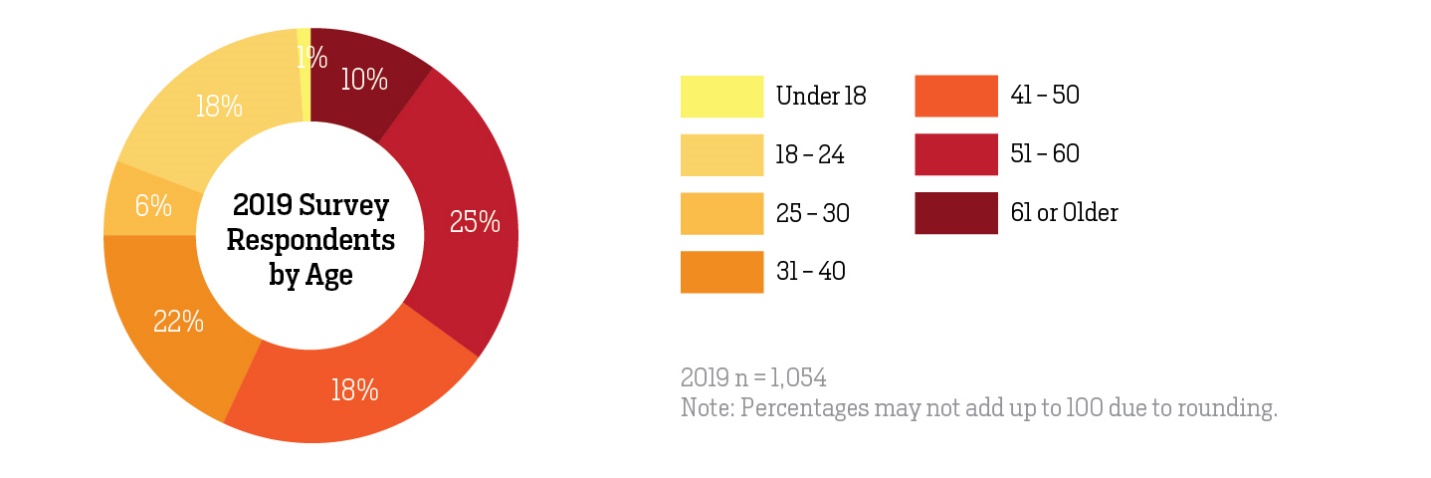
Figure 8. Percentage of people experiencing homelessness by age group (2019).
Source: San Francisco 2019 Point-In-Time Homeless Count and Survey Report, Department of Homeless and Supportive Housing.
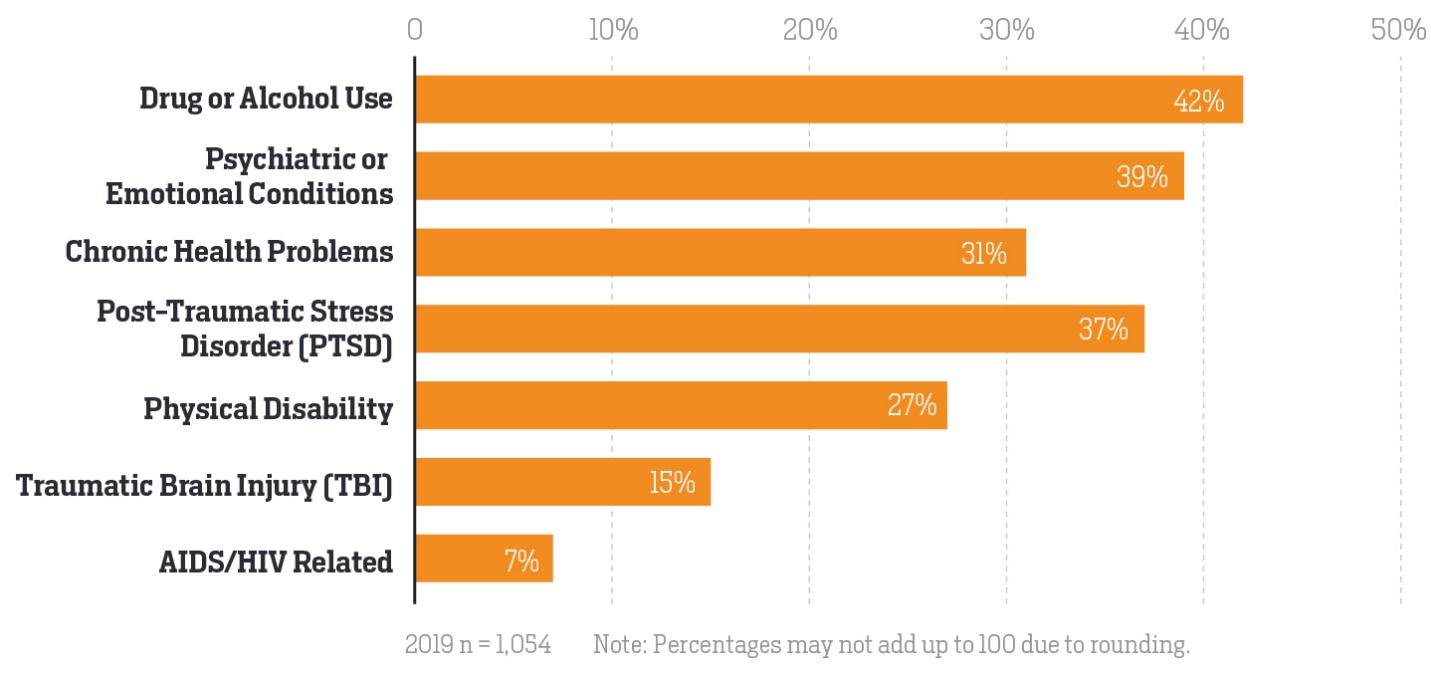
Figure 9. Percentage of people experiencing homelessness with different health conditions (2019).
Source: San Francisco 2019 Point-In-Time Homeless Count and Survey Report, Department of Homeless and Supportive Housing.
OBJECTIVE 1.C
Eliminate homelessness
Challenge - From 2005 to 2019,8 the biennial Point-in-Time (PIT) Count of people experiencing homelessness increased from just over 5,400 individuals to approximately 8,000 individuals. Compared to 2015, homelessness increased by 17% (see Figure 10). Of these, 64% were unsheltered and 38% were experiencing chronic homelessness. Since 2015, the City has expanded considerably the number of Permanent Supportive Housing units, subsidies for operation, and temporary shelters. This will include approximately 4,000 units of additional Permanent Supportive Housing by end of 2022. The City has also reduced the number of unsheltered families. In 2016, the City and County of San Francisco created a new department, the Department of Homelessness and Supportive Housing (HSH), to make a significant and sustained reduction in homelessness in San Francisco through the coordinated provision of services. While improvements have been made at multiple levels, the number of unhoused residents has continuously grown over the years. Moreover, homelessness disproportionately impacts specific populations, such as Black and American Indian residents, transgender and LGBTQ+ people, people with disabilities, domestic violence survivors, and veterans. These inequities require targeted and tailored solutions to effectively meet their housing needs.
Path Forward - Recognizing the right to housing means providing basic access to healthy and dignified living for everyone. Eliminating homelessness is a foundation for this goal, which relies on a comprehensive set of strategies. The City will scale up investments in Permanent Supportive Housing and services, in addition to supporting and promoting other solutions such as housing vouchers, short and long-term rental assistance. For example, in July 2020, the city launched the Flexible Housing Subsidy Pool, a scattered-site Permanent Supportive Housing strategy that matches people experiencing homelessness to private market apartments across the city and provides supportive services so that they remain stably housed. The City will also increase the supply of deeply affordable housing as a homelessness prevention strategy for extremely low- and very low-income households as those households bear a higher risk of homelessness. The City prioritizes addressing chronic homelessness. San Francisco’s current goal is to end family homelessness and reduce chronic homelessness by 50% by December 2022. Eliminating homelessness goes beyond focusing on what is urgent. In the long-term, meeting this objective means securing investments and solutions to also prevent households with less severe vulnerabilities from falling into homelessness.
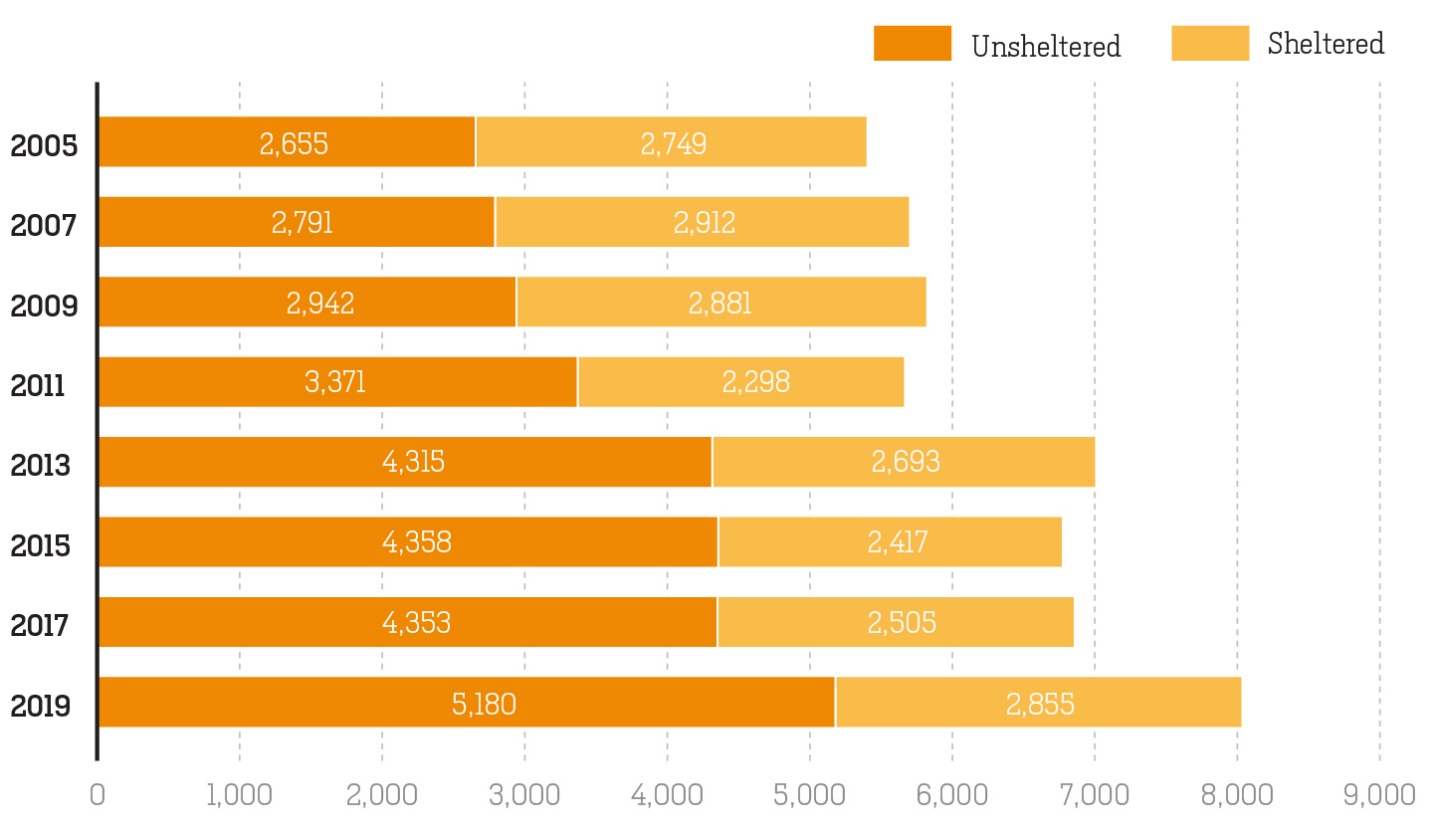
Figure 10. Number of counted people experiencing homelessness in San Francisco by shelter status from 2005 to 2019.
Source: San Francisco 2019 Point-In-Time Homeless Count and Survey Report, Department of Homeless and Supportive Housing.
1. Coley, R. L., Leventhal, T., Lynch, A. D., & Kull, M. (2013). Relations between housing characteristics and the well-being of low-income children and adolescents. Developmental psychology, 49(9), 1775.
2. Hatem, C., Lee, C. Y., Zhao, X., Reesor-Oyer, L., Lopez, T., & Hernandez, D. C. (2020). Food insecurity and housing instability during early childhood as predictors of adolescent mental health. Journal of Family Psychology, 34(6), 721.
3. Ziol‐Guest, K. M., & McKenna, C. C. (2014). Early childhood housing instability and school readiness. Child development, 85(1), 103-113.
4. Office of the United Nations High Commissioner for Human Rights, The right to adequate housing - Fact Sheet No. 21/Rev. 1 (2009). Geneva; United Nations. https://www.ohchr.org/documents/publications/fs21_rev_1_housing_en.pdf
5. National Center for Transgender Equality (2016). 2015 US Transgender Survey: Executive Summary. Washington, DC. Accessible at: http://www.transequality.org/sites/default/files/docs/USTS-Executive-Summary-FINAL.PDF
6. National Center for Transgender Equality (2017). 2015 US Transgender Survey: California State Report. Washington, DC. Accessible at: http://www.transequality.org/sites/default/files/docs/usts/USTSCAStateReport%281017%29.pdf
7. Due to COVID-19, San Francisco did not conduct a PIT Count in 2021. The most recently available data at the time of this report is from 2019. New data from the 2022 PIT Count will be available in the summer of 2022. The final version of this report will be updated to contain the 2021 counts.
8. Due to COVID-19, San Francisco did not conduct a PIT Count in 2021. The most recently available data at the time of this report is from 2019. New data from the 2022 PIT Count will be available in the summer of 2022. The final version of this report will be updated to contain the 2021 counts.
Goal 2: Repair the harms of racial and ethnic discrimination against American Indian, Black, and other people of color.
Challenge - Our nation, from its inception, has initiated and perpetuated harm against people of color, including the genocide, exploitation, and dispossession of American Indian people, the enslavement of Black people, and the systematic denial of suffrage and civil rights to American Indian, Black, and other people of color. San Francisco has participated in this national legacy by creating or enforcing laws, policies, actions, and institutions that have perpetuated racial discrimination and led to disparate outcomes for American Indian, Black, and other people of color (see Figure 11). In San Francisco land use, racial discrimination is evident in the City’s 1870 Cubic Air Ordinance and 1880 Laundry Ordinance which targeted San Francisco’s Chinese population by limiting where they could live or work. In the 20th Century, housing discrimination in San Francisco occurred through direct government action such as urban renewal or redevelopment and through a failure of the City to act to provide equal protection to all San Francisco’s residents in the face of private instruments of racial discrimination including bank redlining (see Figure 12), racial covenants, and predatory subprime loans. Furthermore, the City has at times directly removed targeted communities from their homes through local use of eminent domain or stood quietly by while federal actions like WWII Japanese American incarceration unjustly targeted San Francisco citizens based on their race. Lastly, the majority of American Indian people who live in San Francisco today are here due to the Indian Relocation Act of the 1950s.9 This policy removed American Indian lpeoples from their reservations and relocated them to cities nationwide. The policy enticed American Indian youth to come to seven large urban areas, including the San Francisco Bay, with promises of job training, housing, and stipends. The promises often fell short; checks did not arrive, job training was for menial labor, and people were housed in inferior housing, separated from their families and extended tribal communities. The cumulative effects of these discriminatory acts have contributed to the economic oppression that pushed and continues to push American Indian, Black, and other people of color out of San Francisco. As a result, American Indian, Black, and other people of color continue to face significant income inequality, poor health outcomes, exposure to environmental pollutants, low homeownership rates, high eviction rates, and poor access to healthy food, quality and well-resourced schools, and infrastructure.
Path Forward - San Francisco has a role to play in redressing the compounding effects of racial discrimination against American Indian, Black, and other people of color perpetuated at all levels of government and throughout American society. While federal action is required to redress the harms of American Indian genocide or the enslavement of Black people, San Francisco can incrementally work towards healing these deep wounds and the disparities that have resulted from centuries of oppression. The San Francisco Planning Commission passed a resolution on June 11, 2020, that acknowledges and apologizes for the history of racist, discriminatory, and inequitable planning policies and practices that have resulted in racial disparities. The resolution provides direction for the Planning Department to develop proactive strategies to address and redress structural and institutional racism. The resolution explicitly directs the Planning Department to redress the consequences of government-sanctioned racial harm via meaningful City-supported, community-led processes.
To advance this transformative work, the City must deepen its understanding of the direct harm that discriminatory housing programs and policies caused to American Indian, Black, Japanese, Filipino, and other communities of color in San Francisco. It must also understand the multiple ways in which broader mechanisms of racial and social discrimination reduce a person’s access to housing, such as job discrimination or racial disparities within the criminal justice system. The City must actively dismantle these discriminatory policies by reallocating resources to increase housing access, financial stability, economic opportunities, and community building investments for these communities. Lastly, the City must remain accountable to these communities and transparent in the processes it undertakes to redress harm.
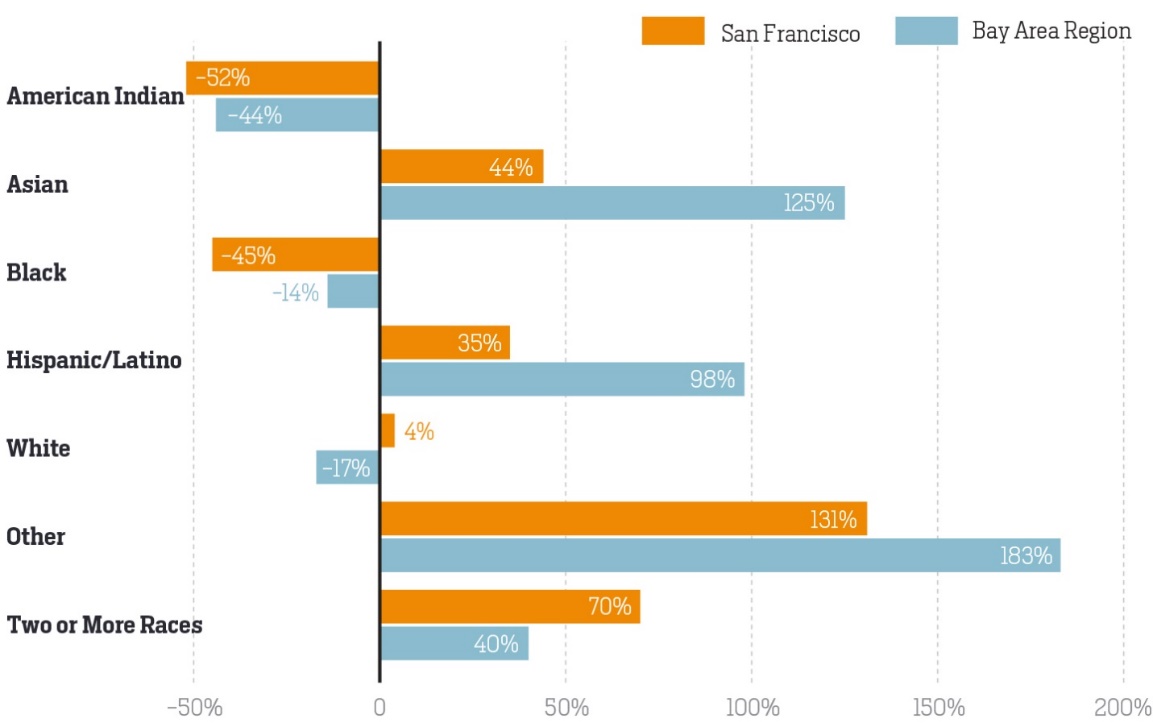
Figure 11. Percentage change of population by race and ethnicity from 1990 to 2015.
Source: 1990 Decennial Census (IPUMS-USA); ACS 2015 5-year Estimates (IPUMS-USA).
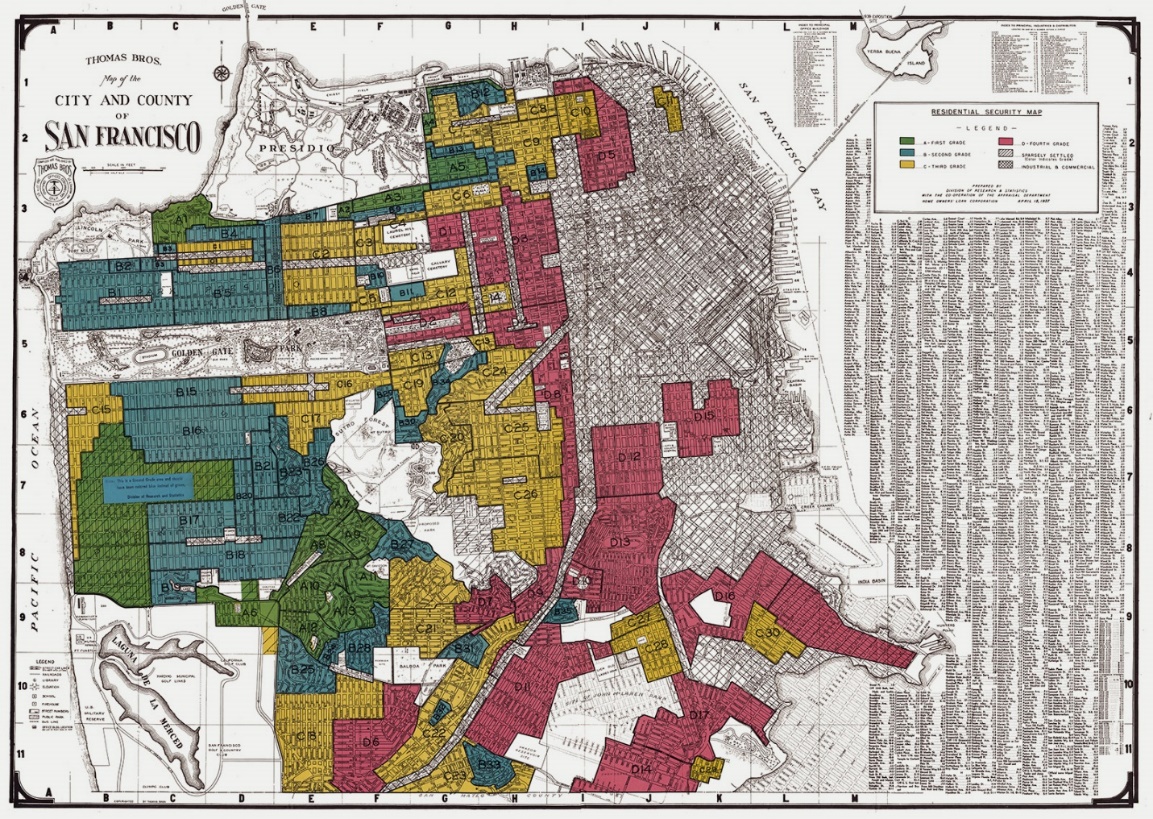
Figure 12. Redlining map shows in red neighborhoods that were discriminated for home and improvement loans.
Source: The University Of Richmond's Mapping Inequality Project.
OBJECTIVE 2.A
Make amends and inform reparative actions by telling the truth about discriminatory actions and the resulting harm
Challenge - Throughout history, communities of color have been the targets of federal, state and locally sponsored and supported programs which have segregated neighborhoods, displaced, and stripped wealth from communities, and undermined their general health and well-being. The impact of these discriminatory actions on American Indian, Black, and other communities of color has yet to be fully documented or understood. While historians have described national events such as the Japanese Internment Bill of 1942 or the Indian Relocation Act of 1956, or government endorsed practices such as redlining (see Figure 12), racially restrictive covenants, and urban renewal, the City needs to study and understand how these actions specifically impacted the residents of San Francisco in order to take reparative action. The City cannot make amends or take steps to repair past harm without identifying the persons who suffered these acts of discrimination and, by speaking with them, documenting the nature and magnitude of the harm. In many cases, this will mean tracking how harm to an individual repercussed through generations and communities. This level of investigation and documentation, centering the voices of the American Indian, Black, and other communities of color, has been limited in San Francisco to date. For example, the Planning Department has constructed historical narratives to explain segregation in public housing or development patterns resulting from redlining and urban renewal to inform the department’s regulatory review; however, the department is only just beginning to apply this information in a reparative framework to ask, “What actions must we take as a department and a city to redress the harm that resulted from these events?” This is a challenging and urgent task because truth-telling will necessarily rely on oral histories to reveal the largely undocumented stories of impacted communities, and first-hand accounts of these events will become rarer as members of those communities pass on. Moreover, the opportunity to repair harm for those individuals will be lost.
Path Forward - To begin to repair and redress the harm, it is crucial that the City undergoes a truth-telling process to acknowledge the impacts government-sanctioned actions that led to wealth loss, disparate housing outcomes and displacement in the American Indian, Black, Japanese, Filipino and other communities of color. This process of investigation, documentation, and acknowledgment is essential for establishing accountability, raising consciousness, and informing the mechanisms and magnitude of resources required to repair the harm. The City must support the affected communities to lead this investigation and documentation, and acknowledgement of harms and their disparate outcomes must be communicated at all levels of power. This truth-telling can illuminate how City agencies build programs that are harm reductive, culturally competent, accessible, and that do not reproduce racist practices from the past. Lastly, truth-telling can begin to correct the erasure from the historic record, both in its written form and in the city’s built-form, that these communities have suffered.
OBJECTIVE 2.B
Offer reparations for communities directly harmed by past discriminatory government action10 and bring back their displaced people
Challenge - Racial discrimination has led to disparate outcomes in income for American Indian, Black, and other communities of color, leaving them vulnerable to housing insecurity and limiting their ability to build intergenerational wealth. The median income for Black households was $30,442 in 2018, 23% of median income for a white household, and for American Indian households’ median income was $61,250 (see Figure 13), 46% of a white household's median income. As a result, these communities are far more impacted by displacement as discussed also in objective 2.b. San Francisco has a moral obligation to repair the harms of racial discrimination, especially those harms for which it holds the greatest responsibility. Calls for reparations from the federal government have occurred since the Civil War, but it was only in 2021 that House Resolution 40, first introduced in 1989 to create a commission to study slavery and discrimination and potential reparations, moved out of committee. In California, Assembly Bill 3121 was enacted on September 30, 2020 to establish the Task Force to Study and Develop Reparation Proposals for Black Americans. And in May 2021, San Francisco’s Board of Supervisors appointed the city’s African American Reparations Advisory Committee, described as the first body of its kind to create a comprehensive reparations plan for Black Americans.
Path Forward - The City can build on current and past local and state initiatives to pursue reparations for American Indian, Black, as well as Japanese American and Filipinos harmed by government actions to create local programs that use housing as tool of repair that addresses persistent housing disparities for these groups and continued community displacement. Reparative acts through housing tools targeted to harmed communities could include dedicating land or housing, offering homeownership loans and grants, ensuring access to below market rate units, facilitating communal forms of land or housing ownership, creating pathways for displaced people and their descendants to return, and strengthening and sustaining their cultural anchors, such as businesses, community and cultural centers, and historic sites.
The city should use the Cultural District program to help anchor and stabilize American Indian, Black and other communities of color by leveraging the community-government partnerships the program has created to lead community planning and guide resource allocation. The program’s mandate requires that the City coordinate resources to assist in stabilizing the districts, which house and provide for vulnerable communities facing, or at risk of, displacement or gentrification. Their community-led processes such as their Cultural History, Housing, and Economic Sustainability Strategies (CHHESS) and direct services, provide a culturally competent framework for stabilizing harmed communities and devising ways to bring back their displaced members.
To incrementally repair the harm inflicted on American Indian and Black people throughout our nation’s history and to reverse the displacement and overrepresentation in homelessness of American Indian and Black residents, the City should support these groups for homeownership opportunities, rental housing assistance and other housing services programs. Similarly, to address direct displacement caused by government actions, the City will explore implementing the newly passed State Assembly Bill 1584 that expands the Certificate of Preference program to serve the descendants of households displaced.
The goal of such actions is to erase racial and ethnic disparities across indicators such as homelessness, homeownership, and rent burden, to improve life outcomes for residents in vulnerable communities, and to grow the city’s communities of color whose populations have been diminished by displacement. Housing reparative acts should work in concert with more comprehensive local, state, and federal efforts to redress the nation’s history of harm against American Indian, Black, and other communities of color.
OBJECTIVE 2.C
Increase accountability to American Indian, BLACK, and other communities of color
Policy 2 Policy 13 Policy 14 Policy 18 Policy 21 Policy 29
Challenge - Limited commitment at the local, state, and federal levels to adequately fund housing programs to meet the City’s existing housing need has contributed to profound public frustration and distrust in the agencies that are meant to serve them. In focus groups for the Housing Element with communities of color and vulnerable groups in 2021, participants reported the sense of powerlessness that they have experienced when attempting to access city programs and resources. Participants shared housing-related experiences that have left them feeling unheard, overwhelmed, exhausted, and powerless to improve housing challenges that seem insurmountable. Participants expressed that existing housing programs and systems sometimes contribute to this sense of powerlessness by de-humanizing already vulnerable community members, and by operating without enough transparency, or accountability to the communities served.
More needs to be done to improve information sharing with the public about why their needs are not being met, how decisions are being made, and why resources have been inadequate. Unmet housing needs for low-income people are the norm around the state and nation as represented by only one Section 8 voucher available for every four qualified households, and very-low-income renters everywhere face cost burdens and a scarcity of affordable housing. Locally, hundreds of households apply for each new affordable housing unit (see Figure 14). American Indian, Black, and other people of color are disproportionately impacted by the failure to adequately fund our housing systems. These are the same communities that are most marginalized from the electoral process and therefore, have fewer means to impact political and government decisions regarding housing policy and resource allocation and to hold those in power accountable to their needs. Likewise, communities of color have not been sufficiently elevated in the City’s outreach and engagement efforts or adequately represented in decision-making bodies, further marginalizing their voices.
Path Forward - The City must create systems of accountability that empower American Indian, Black, and other communities of color with the knowledge and means to effect positive change for their communities. Elevating the voices of communities of color and other marginalized groups will require that the City proactively support community-based organizations in leading community engagement, and planning. Working with community organizations that serve American Indian, Black, and other people of color will help expand access to housing programs and ensure that new policies and larger programmatic changes effectively meet the housing needs of these communities. Outreach and engagement processes should be community-led, culturally appropriate, long-term, and with clear expectations about the outcome of the engagement. Whenever possible, the time and knowledge shared by community advisors should be compensated. Elevating the voices of communities of color also means increasing representation of American Indian, Black, and other people of color in advisory and decision-making bodies.
Improving accountability to advance racial and social equity in housing outcomes will require identifying priorities in this housing plan. While the City needs to significantly expand its resources, priority actions will guide City agencies to prioritize their existing limited resources into actions that carry the highest impact in serving the needs of communities of color, and improving housing affordability for all. Working with bodies and organizations that represent American Indian, Black, and other Communities of color, such as the Community Equity Advisory Council, the African American Reparations Committee, or Cultural Districts, the City will update those priorities frequently, and report on their performance. This process will equip communities of color with more knowledge of the functions and performance of housing programs and policies and the means to hold agencies accountable and support efforts to hold greater power in the decisions that affect their communities. The dissemination of information to and capacity building with American Indian, Black, and other communities of color should expand access to housing programs and result in more effective policies and strategies for meeting the housing needs of their communities.
Additionally, transparent processes and interagency coordination will support the City to continuously identify the funding gaps to implement those priorities and inform the City’s budgeting process. A new racial and social equity analysis framework will help evaluate the impact of the Housing Element’s policies and programs to ensure timely adjustments to increase accountability and effectiveness in advancing racial and social equity. This new framework will include metrics to evaluate progress, and investment solutions to prevent and reverse adverse impacts and to advance equity. Overall, these new tools should make possible a healthier democratic system in which the needs of all residents are more equitably addressed.
| SAN FRANCISCO | $104,552 |
| American Indian / Alaskan Native | $61,250 |
| Black or African American | $30,442 |
| Hispanic or Latino/e/x (Any Race) | $72,578 |
| Native Hawaiian and Other Pacific Islander | $76,333 |
| Some Other Race | $59,497 |
| Two or More Races | $114,399 |
| White (Non-Hispanic) | $132,154 |
Figure 13. Median household income by race and ethnicity (2018).
Source: ACS 2018 5-year Estimates (IPUMS-USA).
| 589 units (new and rental) | Applicants | Occupants |
|---|---|---|
| American Indian / Alaskan Native | 1,818 | 4 |
| Asian | 36,301 | 214 |
| Black or African American | 19,045 | 71 |
| Hispanic or Latino | 28,005 | 140 |
| Native Hawaiian and Other Pacific Islander | 1,710 | 6 |
| White | 18,392 | 90 |
| Other or Multi-Racial | 6,597 | 24 |
| Unknown | 8,169 | 51 |
| TOTAL | 120,037 | 602 |
Figure 14. Below Market Rate Rental Applicants vs Occupants by Race and Ethnicity.
Source: 2019-2020 MOCHD Progress Report
9. SF Human Rights Commission. Discrimination by Omission: Issues of Concern for Native Americans in San Francisco. August 23, 2007. Accessed online March 16, 2022 at: https://sf-hrc.org//sites/default/files/Documents/HRC_Publications/Articles/Discrimination_by_Omission_Issues_of_Concern_for_Native_Americans_in_San_Francisco.pdf
10. Discriminatory programs led or sanctioned by government action, include but are not limited to urban renewal, redlining, segregated public housing, racial covenants, and exclusionary zoning regulations, such as single-family zoning and communities directly harmed include American Indian, Black, Japanese, Filipino, and other communities.
Goal 3. Foster racially and socially inclusive neighborhoods through equitable distribution of investment and growth.
Challenge - Racial and economic segregation is defined by the UC Berkeley Othering and Belonging Institute (OBI) as “an attempt to deny and prevent association with another group, and a strategy that institutionalizes othering of racial or social groups through inequitable resource distributions.11
Racial concentrations overlapped with concentration of low-income households are strongly visible in San Francisco (Mission, Fillmore and Bayview, Chinatown, SoMa) indicating segregated living patterns (Figure 15). Many of these neighborhoods have hosted most of the new growth, with 85% of new housing built since 2005 concentrated in the eastern and central parts of the city: Downtown/South Beach, SoMa, Mission Bay, Potrero Hill/ Dogpatch, Bayview Hunters Point, the Mission, Tenderloin, and Hayes Valley (see Figure 16). While these investments in housing development brought new infrastructure, jobs, and residents to the east side, many lower income communities of color were locked out of access to these benefits and are still contending with the lingering effects of discrimination that make them more vulnerable to homelessness, evictions, and displacement. At the same time, well-resourced neighborhoods with greater access to parks, quality schools, better environmental conditions, and with higher median incomes have experienced the lowest rates of new housing development over the last few decades. Multi-family homes in these neighborhoods are either not currently allowed or zoning restrictions render them too expensive to deliver. These restrictions have the effect of excluding low- and moderate-income households from being able to live in these neighborhoods and in that way serve to maintain racial and economic segregation in San Francisco (see Figure 17).
Path Forward - A new state law, Affirmatively Furthering Fair Housing (AFFH), requires that all public agencies administer programs and activities related to housing and community development in a manner that promotes fair housing. Affirmatively furthering fair housing means “taking meaningful actions, in addition to combating discrimination, that overcome patterns of segregation and foster inclusive communities free from barriers that restrict access to opportunity.”12 The California Department of Housing and Community Development (HCD) prescribes that in order to prevent further segregation and concentration of poverty, and to increase access to opportunity and redress past actions that led to current inequities, city agencies and decision-makers “must create land-use and funding policies to increase affordable housing in high resource neighborhoods that have often been exclusionary (explicitly or indirectly due to costs or zoning policies) and bring additional resources to traditionally under-resourced neighborhoods.”13
The goal of greater integration, and racially and socially inclusive neighborhoods, relies on building intergenerational wealth within areas14 with high concentration of American Indian, Black, or other communities of color. This goal requires the City to ensure low-income communities and communities of color can also benefit from investment in housing, including the opportunity to build wealth. The goal also requires the City to open wealthy, white, and well-resourced neighborhoods to all communities of color and low-income households in order provide access to high-quality neighborhood resources that foster positive economic and health outcomes. To prevent further inequities as an unintended impact of investments, targeted anti-displacement investments are needed to stabilize existing racially and socially inclusive communities.
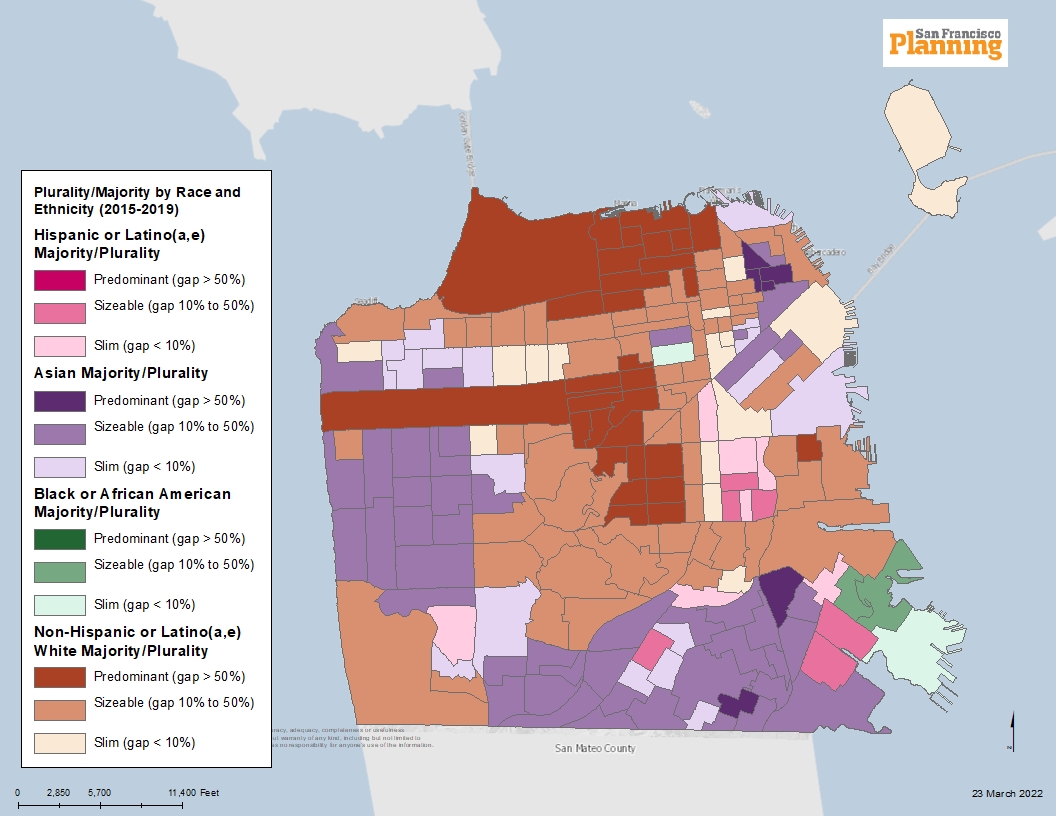
Figure 15. Map of predominant racial and ethnic concentrations and Racially and Ethnically Concentrated Areas of Poverty (R/ECAP) (2017).
Source: Esri, Predominant Race/Ethnicity by Block Group, 2013-2017 (2013-2017 American Community Survey 5 Year)
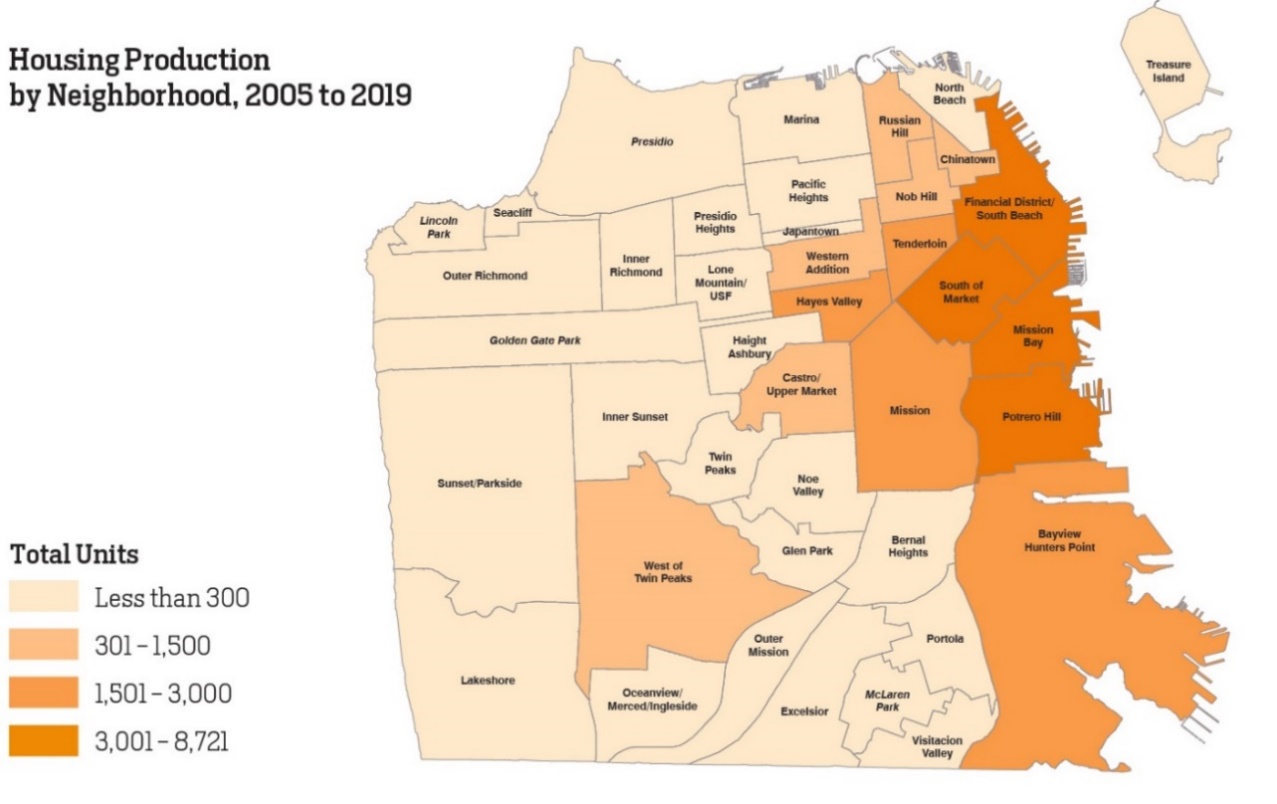
Figure 16. Map of housing production by neighborhood from 2005 to 2019.
Source: San Francisco Housing Affordability Strategies (2020).
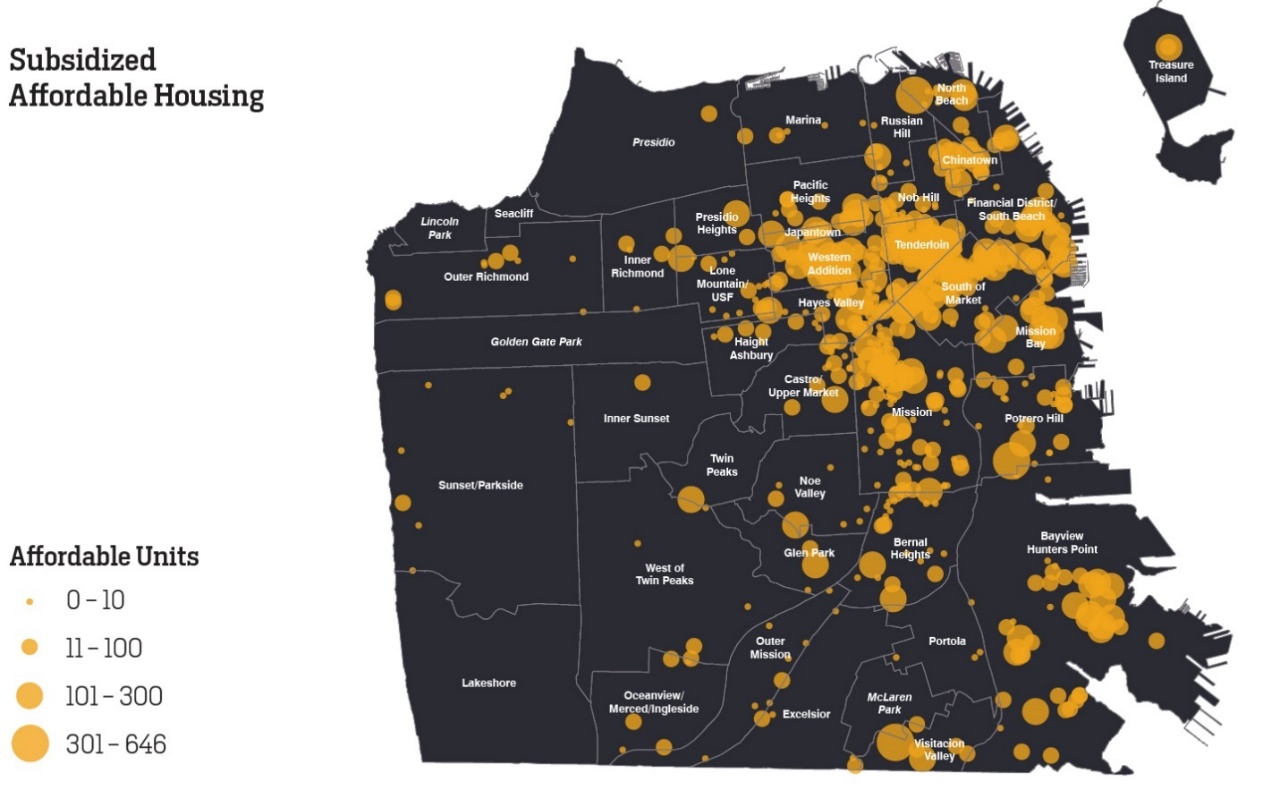
Figure 17. Map of permanent affordable housing by units per building (2018).
Source: San Francisco Housing Affordability Strategies (2020) with data from the San Francisco's Mayor's Office of Housing and Community Development (2018).
OBJECTIVE 3.A
Build intergenerational wealth for American Indian, Black, and other communities of color15
Policy 5 Policy 11 Policy 12 Policy 15 Policy 16 Policy 18 Policy 38
Challenge - Government actions in the form of redevelopment and urban renewal have dispossessed specific communities in San Francisco, such as American Indian, Black, Japanese, Filipino, and other communities, of homes and entire neighborhoods. The median household wealth (the difference between total assets and total debts) for white households is more than five times greater than Latino/e/x households and more than seven times greater than Black households (see Figure 18). Income data from San Francisco echoes these national trends (see Figure 13). The median income for Black households is less than one fourth of non-Hispanic white households. Similarly, the median household income for American Indians ($61,250), Latinos/es/x ($72,578), and Asians ($88,016) was also lower than non-Hispanic white households.
These wealth gaps have left households of color more likely to experience housing instability and cycles of intergenerational poverty, and often unable to build wealth to pass down to their children over decades. Wealth allows people and families to secure safe and healthy housing, open businesses, sustain themselves in retirement, and facilitate education and access to homeownership for their children. Homeownership is one of the primary sources of building wealth for most U.S. families. But decades of lost opportunity due to housing discrimination and neighborhood disinvestment, along with educational and workplace discrimination, have locked many people of color out of homeownership and contributed to the racial wealth gaps we see today. While some neighborhoods with the high concentration of low-income American Indian, Black, and other communities of color in San Francisco have experienced significant housing and infrastructure investments in the past two decades, these communities have experienced limited benefits and, in some cases, experienced displacement of residents and businesses. In addition, these low-income communities of color have had limited access to the new permanently affordable housing units due to income or credit requirements beyond their reach.
Path Forward - Racially and socially inclusive neighborhoods rely on low-income American Indian, Black, and other communities of color having the opportunity to build wealth to pass on to future generations. This Housing Element defines Priority Equity Geographies, as places where the city will target direct investments to achieve this outcome and implement reparative strategies described in the previous goal (see Figure 19). Wealth building strategies should start with a people-based approach and include access to affordable housing and homeownership, as well as trainings for well-paid jobs, business ownership, and fostering financial literacy and readiness. Wealth building strategies will also include place-based strategies to improve access to opportunity: resources in one’s neighborhood that are linked to positive economic, social and health outcomes for communities, such as quality public schools, affordable and accessible transportation options that connect residents to educational and economic development opportunities, affordable community serving businesses, and a healthy environment. These resources create the conditions for thriving neighborhoods that, along with people-based approaches, can build lasting wealth that can be passed on from one generation to the next.
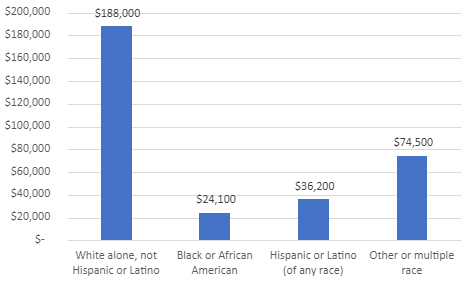
Figure 18. National median household wealth (2019).
Source: US Federal Reserve (2019)
Figure 19. Map of Priority Equity Geographies.
Source: San Francisco Department of Public Health’s Areas of Vulnerability map.
Note: Priority Equity Geographies are areas with a higher density of vulnerable populations as defined by the San Francisco Department of Health, including but not limited to people of color, seniors, youth, people with disabilities, linguistically isolated households, and people living in poverty or unemployed.
OBJECTIVE 3.B
Create a sense of belonging for all communities of color within Well-resourced Neighborhoods16 through expanded housing choice
Challenge - Well-resourced Neighborhoods are areas the state has identified in each jurisdiction as places that have a high concentration of resources that have been shown to support positive economic, educational, and health outcomes for low-income families — particularly long-term outcomes for children (see Figure 20). Since 2005, just 10% of all new housing in San Francisco and 10% new affordable housing has been built in Well-resourced Neighborhoods though these areas cover nearly 52% of the residential land in the city (see Figures 16 & 17). In part this is because 65% of land in these areas is limited to one or two units and most of the rest also has fixed restrictions on the number of units allowed- even near major commercial districts and transit lines (see Figure 21). This pattern of development has had a two-fold effect on low-income communities and communities of color which mostly reside outside of these neighborhoods. First, these communities disproportionately carry the burden of accommodating growth in our city. Second, a lack of new housing, particularly affordable housing, in neighborhoods with better services and amenities means those neighborhoods remain largely inaccessible to low-income communities and communities of color.
Current restrictions on the number of homes that can be built on most of the city’s residential land date largely to the 1970s, when the city faced a substantially different housing context. The city had lost population from 1950 to 1980 as many middle- and high-income households, who were typically white, moved to rapidly growing suburban communities of single-family homes. Jobs were also growing quickly in suburban areas including manufacturing, logistics, and new suburban office parks. The amount of housing produced regionally was significantly higher than today and housing costs were lower to what people earned at the time. These zoning changes from the 1970s often were an indirect way to institutionalize and perpetuate racial and social exclusion from affluent, white neighborhoods in San Francisco. These practices and regulations are known as exclusionary zoning.
Path Forward - Fostering racially and socially inclusive neighborhoods throughout the city means increasing housing choice for all in all neighborhoods. It means ensuring access to housing for American Indian, Black, and other communities of color across all neighborhoods. To promote a sense of belonging for all communities in Well-resourced Neighborhoods, the City needs to shift course regarding where new housing is built, so more diverse communities can call these neighborhoods home. The new Affirmatively Furthering Fair Housing Law also requires local jurisdictions to create programs that would reverse segregation and promote inclusive neighborhoods, including allowing for more housing, particularly affordable housing, to be built in Well-resourced Neighborhoods. Increasing housing development capacity through changes to zoning in Well-resourced Neighborhoods, focusing on small- to mid-rise multifamily buildings is the first step the City must pursue to shift development patterns. Increasing housing choice in these areas also will rely on Incentives and community benefits in order to provide housing choices affordable to not just to low-income residents, but also to middle-income residents, families with children, seniors, and people with disabilities. Opening access to housing choices in the Well-resourced Neighborhoods must be supplemented with strategies to foster openness to new neighbors, support to those previously excluded in accessing new neighborhoods, and financial strategies for affordable housing.
Figure 20. Map of Well-resourced Neighborhoods.
Source: 2020 TCAC/HCD Opportunity Map.
Note: Well-resourced Neighborhoods are shown below and defined as “High Resource/Highest Resource" by the California Fair Housing Task Force. The purpose of this map is to identify every region of the state whose characteristics have been shown by research to support positive economic, educational, and health outcomes for low-income families—particularly long-term outcomes for children.

Figure 21. Map of simplified zoning categories for the Housing Affordability Strategies analysis.
Source: San Francisco Housing Affordability Strategies.
OBJECTIVE 3.C
Eliminate displacement of vulnerable communities17 and communities of color
Policy 1 Policy 3 Policy 11 Policy 18 Policy 21 Policy 29
Challenge - Due to social and economic inequities, low-income households and households of color are particularly vulnerable to displacement. The impacts of displacement, the involuntary or forced movement of households due to causes outside of the household’s ability to control on communities are deep and destabilizing. Members of displaced communities report feelings of loss, anxiety, and fear,18 experience the disintegration of social fabrics,19 face greater food insecurity,20 and self-report poorer health outcomes.21 In San Francisco, economic booms are often accompanied with an increase in eviction rates (see Figure 22).
Eviction notices are only one metric to measure displacement. The Urban Displacement Project has measured displacement through a variety of social and economic indicators (see Figure 23),22 including new metrics such as in and out migration to neighborhoods.23 Displacement constitutes not only loss of people but also cultural heritage, businesses and services, and social networks, all of which provide vital spaces for immigrants, transgender and LGBTQ+ residents, people of color, and other groups. These resources are also essential to the fabric of San Francisco. Displacement is more likely to occur in neighborhoods with high populations of seniors, low-income households, and Black, American Indian, and other communities of color, making these populations even more vulnerable and disadvantaged. Studies have suggested that major infrastructure improvements, such as new rail or major transit investments, could result in displacement impacts if parallel anti-displacement investments have not been made.24 Low-income communities of color also have expressed concerns about displacement due to rental and price adjustments which can occur along with major zoning changes, or major new market-rate buildings. At the same time neighborhoods without such investments have also experienced high eviction rates and have been identified as vulnerable to displacement, such as places in the Richmond and Sunset.
Path Forward - Preventing further displacement is key to the goal of racial and socially inclusive neighborhoods as it contributes to greater neighborhood and individual stability and cultivates culturally appropriate commercial and social spaces for the most vulnerable communities. The City must understand and measure displacement impacts more clearly and directly to prevent further displacement. Upcoming analyses will identify metrics to measure displacement, especially in geographies identified as vulnerable to displacement. The findings of that analysis will inform anti-displacement investments that will ameliorate, and ideally reverse the displacement impacts. Anti-displacement investments include funding eviction defense programs, such as right to counsel and tenant rights education, bolstering and enforcing existing eviction protections and rent stabilization laws, and providing relief through emergency or targeted rent subsidies, as well as medium- to long-term investments such as preservation of affordability of existing housing that primarily house low-income households and households of color, and building new permanently affordable housing targeted to communities vulnerable to displacement.
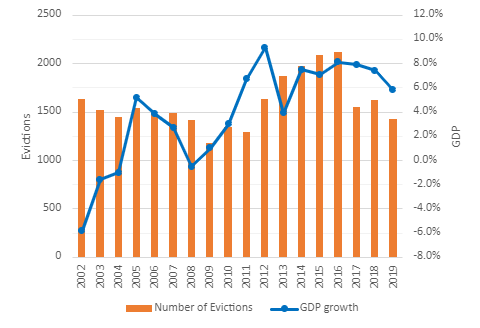
Figure 22. GDP growth and eviction notices in San Francisco from 2002 to 2019.
Source: San Francisco Rent Board, US Bureau of Economic Analysis
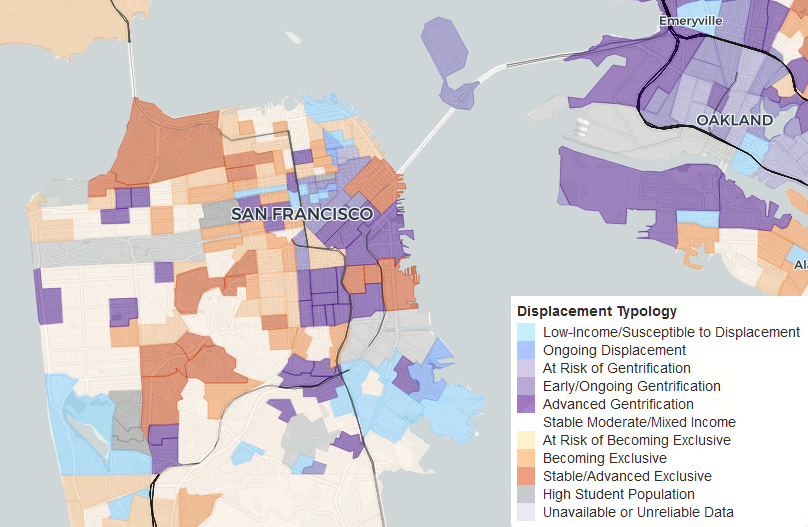
Figure 23. San Francisco Bay Area gentrification and displacement map.
Source: San Francisco Bay Area Gentrification and Displacement Map, Urban Displacement Project; accessed in January 2022.
11. https://www.otheringandbelonging.org/the-problem-of-othering/
12. AB 686 https://leginfo.legislature.ca.gov/faces/billNavClient.xhtml?bill_id=201720180AB686.
13. https://www.hcd.ca.gov/community-development/affh/docs/affh_document_final_4-27-2021.pdf#page=16
14. Ibram Kendi, “How to Be an Antiracist” (One World, August 13, 2019).
15. For the purpose of the Housing Element these communities are defined as Priority Equity Geographies that are identified and updated by Department of Public Health’s Community’s Health Needs Assessment as Areas of Vulnerability.
16. These areas are identified under California Housing and Community Development Opportunity Area Maps, as high and highest resource.
17. Areas identified in the Urban Displacement Project’s displacement and gentrification analysis as vulnerable or undergoing displacement or gentrification. This analysis is undergoing an update and a new version will be released early 2022, which will inform changes to the definition used under this objective.
18. Atkinson, Rowland, Maryann Wulff, Margaret Reynolds, and Angela Spinney. "Gentrification and displacement: the household impacts of neighborhood change." AHURI Final Report 160 (2011): 1-89.
19. Betancur, John. "Gentrification and community fabric in Chicago." Urban studies 48, no. 2 (2011): 383-406.
20. Whittle, Henry J., Kartika Palar, Lee Lemus Hufstedler, Hilary K. Seligman, Edward A. Frongillo, and Sheri D. Weiser. "Food insecurity, chronic illness, and gentrification in the San Francisco Bay Area: an example of structural violence in United States public policy." Social science & medicine 143 (2015): 154-161.
21. Izenberg, Jacob M., Mahasin S. Mujahid, and Irene H. Yen. "Health in changing neighborhoods: A study of the relationship between gentrification and self-rated health in the state of California." Health & place 52 (2018): 188.
22. Social and economic indicators include: household income, change in household income, housing costs, rent increases, and housing affordability.
23. Chapple, K., & Thomas, T., and Zuk, M. (2021). Urban Displacement Project website. Berkeley, CA: Urban Displacement Project.
24. Zuk, Miriam, Ariel H. Bierbaum, Karen Chapple, Karolina Gorska, and Anastasia Loukaitou-Sideris. "Gentrification, displacement, and the role of public investment." Journal of Planning Literature 33, no. 1 (2018): 31-44.
Goal 4. Provide sufficient housing for existing residents and future generations for a city with diverse cultures, family structures, and abilities.
Challenge - San Francisco has been in a state of affordability crisis in the past couple of decades, a crisis felt by low-, moderate-, and, more recently, middle-income households. Current residents or workers wanting to call San Francisco home cannot afford the housing they need. While this crisis is fueled by the consistent housing shortage throughout the state, San Francisco has become one of the least affordable cities in the nation. The median condominium price of $1.2 million is affordable to households making $222,000 annually. Less than 25% of San Francisco households earn this income and less than 10% of San Francisco workers have this salary. In 2022, median rent was $3,800 for a 2-bedroom apartment, affordable to a household earning $137,000, that is less than 40% of our households.
During the economic boom of the last decade, the city attracted major job growth particularly high salaried jobs. The increasing demand for city living by high earning households, along with historic low housing production rates drove up the rental and sales prices (see Figure 24), and triggered waves of displacement especially in low-income communities of color (see Figure 4). This challenge has been compounded by a significant decline of public funding for affordable housing from the Federal and State governments over the past four decades. High housing costs in our region mean that this disinvestment has had an even greater impact. Securing State affordable housing funds has become more competitive recently, and San Francisco does not fare well due to high costs of construction. Staggeringly high costs of housing development also mean that new homes delivered by private investment are only affordable to higher-income earners, further aggravating the affordability crisis. High costs of construction material, skilled labor priced out of living in the region, and complex review and permitting processes, and with increased investment risk all contribute to increases in the cost of building homes.
As the cost of living in San Francisco has ballooned over the years, the city has lost much of the diversity that once defined its identity. Seniors, families with children and middle-wage workers are confronted with very limited choices. Many are forced to find housing choices that meet their needs across the bay or further away and endure long commute hours. Many are forced to leave the Bay Area or California completely. The City has been unable to provide the needed housing for the diversity of workers that our economy requires and most importantly the housing for our diverse cultures and communities that define the essential values of San Francisco.
Path Forward - There has been a growing commitment to address housing scarcity in California. Cities throughout the state are required to facilitate sufficient housing that not only responds to natural population growth but also address existing housing needs. These needs are measured by the share of households who bear high housing cost burden (paying more than 30% of their income on rent), or by those living in overcrowded conditions (more than one person per room, including the living room), or by low rates of available units on the market for rent or sale. San Francisco’s allocation for the 2023-2031 cycle is 82,069 units, over three times the targets of the most recent regional planning cycle (2014-2022) (See Figure 25).
Many studies illustrate the importance of increasing the supply of housing to address the affordability crisis throughout California. New market-rate housing is generally only affordable to high-income earners. In San Francisco, new housing is also mostly limited to certain neighborhoods, and often in certain typologies within high-rise or mid-rise buildings that may not serve families with children, multi-generational living, or seniors.
Achieving the goal of providing sufficient housing will require providing an abundance of permanently affordable housing, which requires a substantial increase in public funding. It also means continuing production of market-rate housing for all segments of San Francisco’s workforce. It means supporting private investments to build housing for middle-income households. Small and mid-rise multi-family buildings have been a typology that historically played this role without public subsidies or income restrictions. This is a typology that fits the scale of most of San Francisco’s neighborhoods, and new strategies can promote the feasibility of these buildings. The City’s future diversity also relies on ensuring that new housing responds to the needs of a diversity of cultures, incomes, household types and family structures, age, and abilities.
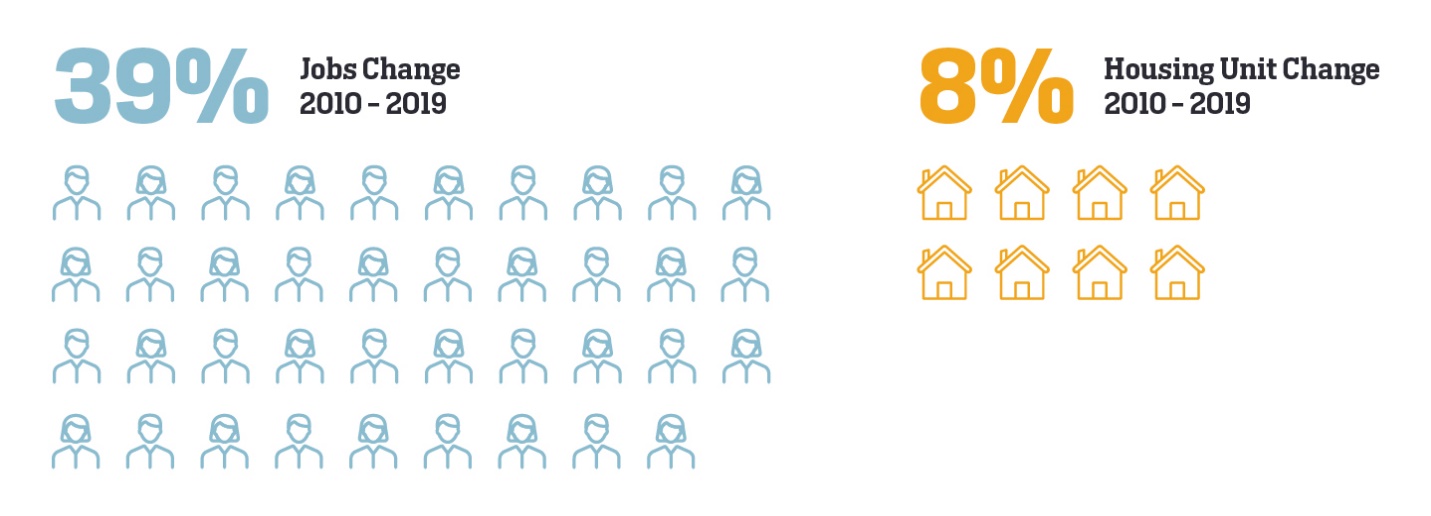
Figure 24. Percentage change in job growth compared to percentage change in housing unit production from 2010 to 2019.
Source: 2010, 2019 BLS QCEW; ACS 2010 and 2019 1-Year Estimates.
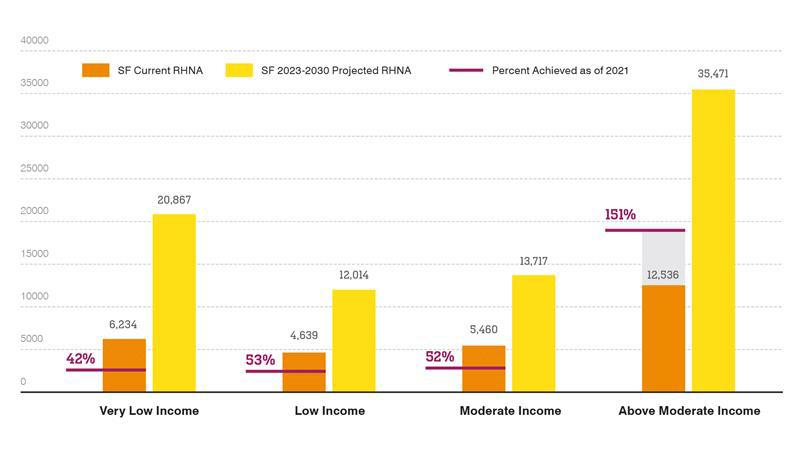
Figure 25. San Francisco Regional Housing Needs Allocation by income level (Cycle 5 vs Cycle 6).
Source: ABAG
OBJECTIVE 4.A
Substantially expand the amount of permanently affordable housing for extremely low- to moderate-income households
Policy 3 Policy 8 Policy 15 Policy 19 Policy 22 Policy 23 Policy 24 Policy 26 Policy 27 Policy 28 Policy 29 Policy 30
Challenge - Building housing permanently affordable to people with extremely low- to moderate- incomes requires subsidy to cover the gap between the cost of development and operations and the reduced revenue due to lower rents and prices. Annual affordable housing production has varied from year to year over the past decade, generally following overall housing production (see Figure 26). Federal funding for affordable housing has continually decreased for the past several decades. In the past 15 years, San Francisco has only built or preserved 13,320 units permanently affordable to extremely low- to moderate-income households, 33% of our regional targets. San Francisco also lost a significant and continuous source of funding due to State dissolution of Redevelopment Agencies in 2011. To continue building affordable housing, non-profit developers piece together a variety of public and private funding sources. The City also created new sources of local funding to make up for the loss of redevelopment funds. These include:
Affordable housing trust fund, established in 2012, a general fund set aside of approximately $50 million/yr for 30 years.
Employer gross receipts tax, established in 2018, expected to create $300 million per year for supportive housing.
Real Estate Transfer tax for properties valued at $10 million or higher, expected to create $196 million per year.25
Affordable Housing General Obligation Bonds, $310 million in 2015, and $600 million in 2019, and $147 million in the Health and Recovery G.O. Bond in 2020.
Despite limited funding sources, San Francisco continues to build affordable housing at a faster rate than most other cities. According to the Housing Affordability Strategies report, the City needs to spend over $517 million per year on building or preserving permanently affordable housing to secure 30 percent affordability of 5,000 new or preserved units (see Figure 27a). This study assumed an average cost of construction of $700,000 per unit and a subsidy of $350,000. The City was able to reach the high funding target in 2019. With the additional funding from the new gross receipts tax for Permanent Supportive Housing, the City reached approximately $650 million in 2021 for production and preservation of affordable housing. However, the new RHNA goals have increased significantly and will require substantially larger investments. Initial analysis shows a significant deficit per year to meet the affordability targets ranging from $1.3 billion in the 2023 to $2.5 billion in 2031. This gap also relies on private development providing a portion of our affordable housing units through inclusionary requirements and contributing to housing related fees such as jobs housing linkage fees.
Path Forward - Substantial expansion of permanently affordable housing for extremely low to moderate-income households is a critical pillar of addressing housing needs and housing our workforce. Without that investment the City will continue to lose its racial, social, and cultural diversity. To achieve this objective, the City must seek new paths to substantially expand funding sources for affordable housing whether through new local sources, or expanded State and Federal funding. Figure 27(b) shows projected funding that is fairly certain. The City should utilize the two new sources of funding, gross receipts tax, and the Real Estate Transfer tax, to partially meet our funding gap, and consider new funding sources such as a new affordable housing bond, and other sources to meet the gap. Reducing the cost per unit for building affordable housing is also a critical path forward, which can be possible with streamlined review, and neighborhood support of mid-rise buildings for permanently affordable housing in all neighborhoods. The City will continue and expand streamlined review of all permanently affordable housing, reduce the cost of construction in regulatory review processes, and rely on innovative materials to make more efficient use of limited public funds. The City must also distribute affordable housing investments across all neighborhoods, including investments in Well-resourced Neighborhoods where the production of affordable housing has been limited. Expanding the types of permanently affordable housing beyond non-profit owned and operated or privately-owned below market rate rental units into cooperative housing, shared equity models, and land trusts will expand paths to increase affordable homeownership opportunities. The City must also target its investment to provide permanently affordable housing that serves the particular needs of vulnerable groups, such as transgender and LGBTQ+, transitional-aged youth, seniors and people with disabilities, and families with children. As the City, state and federal governments, continue to expand investment in affordable housing, it is important to recognize the role of private housing developers in building permanent affordable housing, through inclusionary requirements, or affordable housing fees. Beyond the distinct contributions of the government and private sectors, the City must continue to support public-private partnerships to leverage public funds with private investments to maximize the number of affordable housing units produced.
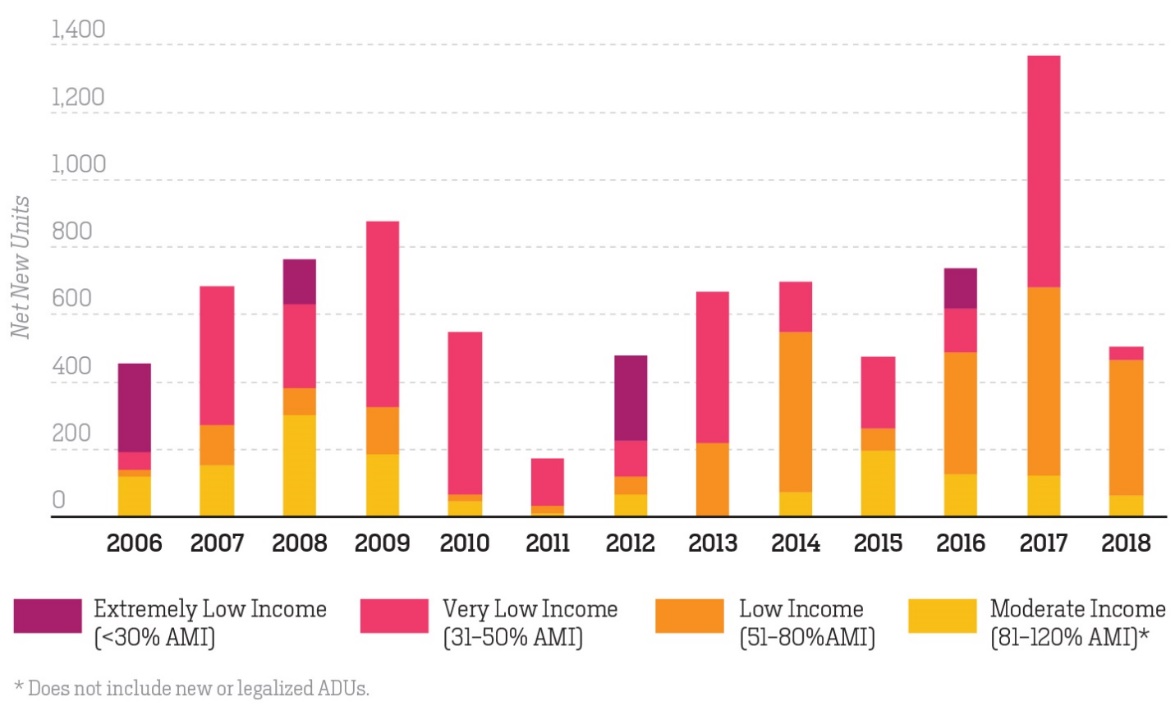
Figure 26. Affordable housing production by income level from 2006 to 2018.
Source: City of San Francisco Planning Department Housing Inventory Reports, 2006 to 2018; Strategic Economics, 2020.

Figure 27B. Affordable Housing Expenditures by Source Past (2006-2019) and Projected (2020-2030)
Note: OCII will fund about 2,500 new affordable units on specific sites to meet its enforceable obligations in coming years and these units are accounted for in the 50,000 unit, 30-year total. Redevelopment and OCII are included in past expenditures above because they were the main affordable housing funding source. Projected expenditures by funding source shown above and the $517 million estimate of annual funding need are for MOHCD-funded affordable units and do not include OCII.
(1) Includes HOME and CDBG
(2) Includes land sales and Certificates of Participation (COPs)
(3) Includes area-specific fees, inclusionary housing fees, and jobs-housing linkage fees
(4) Includes 2015 Proposition A and 2019 Proposition A housing bonds In 2019
(5) The Board of Supervisors passed an ordinance to establish the use of excess Education Revenue Augmentation Fund (ERAF) revenue for affordable housing production and preservation
OBJECTIVE 4.B
Expand small and mid-rise multi-family housing production to serve our workforce, prioritizing middle-income households
Policy 4 Policy 20 Policy 25 Policy 26 Policy 27 Policy 28 Policy 29 Policy 30 Policy 31
Challenge - While middle income households in San Francisco were not cost burdened (paying more than 30 percent of their income for housing) at all in 1990 more recent data shows that middle-income households are now cost-burdened (see Figure 3). San Francisco’s housing costs are so high that even middle-income households – such as teachers, nurses, or first responders - are increasingly finding it hard to remain in the city. Data from the San Francisco Unified School District, for example, shows that anywhere from 300 to 700 educators leave San Francisco every year, leading to a shortage of teachers. While middle-income households may find rental housing affordable in many neighborhoods, median sales prices are completely out of reach. Middle-income households can find homeownership opportunities more easily across the bay, and that alone presents an incentive to leave the city.
Middle-income households have been increasingly left out as a target for newly built private market housing. While San Francisco has consistently met or exceeded regional housing targets for “above moderate-income households,” this housing is not affordable to middle-income households. Factors contributing to this high cost include: land value, construction material costs, labor shortages, a complex regulatory environment, lengthy permitting processes, as well as uncertainties of discretionary approval processes. The high cost of developing housing increases investment risk and focus on projects that can endure uncertainty and yield higher rents and sales prices.
The cost of housing is also conditioned by the city’s attractiveness to workers, businesses, and investors from the region, the country, and the world.26 San Francisco has been an attractive place for many high-income workers and investors around the world. This attractiveness makes housing in San Francisco a valuable global commodity. The availability of resources to pay for housing partially defines what is being produced by the private market for new housing and drives the market for renovations and modification to existing housing stock. These trends have resulted in market rate housing that is only affordable to higher-income earners.
These pressures leave middle-income households with very limited choices, as federal and state funding resources only target lower income households for affordable housing. The City has recently created programs, such as educator housing, that would produce deed restricted units for eligible middle-income households. Inclusionary requirements for market rate housing have also been updated to include below market rate units that are affordable to households earning up to 150% of AMI, or $179,850 for a three-person household. Relying on City housing subsidies to serve middle-income households would certainly mean taking away limited public funding resources from moderate-, low-, and very low-income households who are left without choices in most of the region.
Path Forward - Finding new paths to ensure that the private housing market serves the middle-income workforce is key to maintaining our city’s diversity. Expanding where small and mid-rise buildings can be constructed throughout the city provides a path for the market to provide more middle-income housing opportunities without public subsidy. This objective will be met not only by increasing development capacity for small and mid-rise buildings in areas where they are not currently allowed, but also by removing uncertainty from regulatory review processes, streamlining review, and cost abatements. The smaller scale of these buildings fit within the existing scales of most of the neighborhoods in the city which provides better opportunities for a clearer regulatory framework and streamlined processes, including units that serve middle-income households without deed restrictions. Adding new units to our existing housing stock on vacant lots, and through demolition and reconstruction is a critical strategy to increase small multi-family homes particularly for middle income households. However, new units should meet the affordability rates of existing units and tenants should be offered competitive relocation programs during construction. As building multi-unit buildings has been legalized in areas designated for single-family homes throughout the city and the State, the City must encourage multi-family buildings whenever possible. The retention of single-family homes should include contributions towards affordable multi-family housing given the missing opportunities and high use of land and infrastructure resources by a single household.
OBJECTIVE 4.C
Expand and diversify housing types for all
Policy 7 Policy 32 Policy 33 Policy 34 Policy 35 Policy 36
Challenge - San Francisco is home to a diverse range of family and household structures including multigenerational families, LGTBQ+ families, single parents, roommate living, artist co-ops, single-person households, couples, or families with multiple children among many others. As people’s lifestyles change, children move out, families grow, partners move in or out, or physical abilities change, their housing needs change as well. San Francisco residents are finding it increasingly challenging to find housing that meets their changing needs, either within their current neighborhood, or anywhere in the city. Households with children, particularly those with two or more children are having an increasingly hard time staying in San Francisco (see Figure 28), and households with children in San Francisco experience high rates of overcrowding (more than 1 person per room, including the living room) as well (see Figure 29). Other household types are also experiencing pressure: many have been doubling or tripling up to live in the City as roommates or related adults (see Figure 29). Many are forced to live in these arrangements or leave the City because they cannot find housing that is within their financial reach and meets their needs. Seniors, aging adults, and people with disabilities are unable to afford living conditions that match their abilities. A two-person educator household is likely cost burdened (paying more than 30% of their income on rent) or may not live in housing that meets their needs if interested in growing their family. Artists who once found a haven in San Francisco, and who are often the promoters of the city’s diverse cultures, are turned away without viable housing choices.
Path Forward - Ensuring a diversity of housing types at various affordability levels is critical to maintaining and advancing the diversity that once defined San Francisco. The City must employ targeted programs and products that serve the particular needs of seniors, people with disabilities, transgender and LGBTQ+, transitional aged youth, or families with children. To meet these unique needs, new housing must offer varying design and amenities, promote certain typologies, be located in certain neighborhoods, or in proximity to transit amenities. For example, promoting co-housing27 will address the growing interest among some communities in living in small rooms with shared amenities (kitchen, living room, etc.). Housing for seniors and people with disabilities, at variety of income levels, must be promoted along transit corridors to address limited mobility issues. Transgender and LGBTQ+ households are interested in living in neighborhoods where they have built a community over decades. Families with children, at a variety of income levels, need improved access to child friendly amenities, and shared open spaces. All neighborhoods should provide a range of housing types, at a range of affordability levels, as well as amenities that serve the changing needs of seniors, children, people with disabilities, young individuals, and various family structures.

Figure 28. Percentage change in number of households with children from 1990 to 2015.
Source: San Francisco Housing Needs and Trends Report. Data: Decennial Census (1990 and 2000) and ACS (2015)
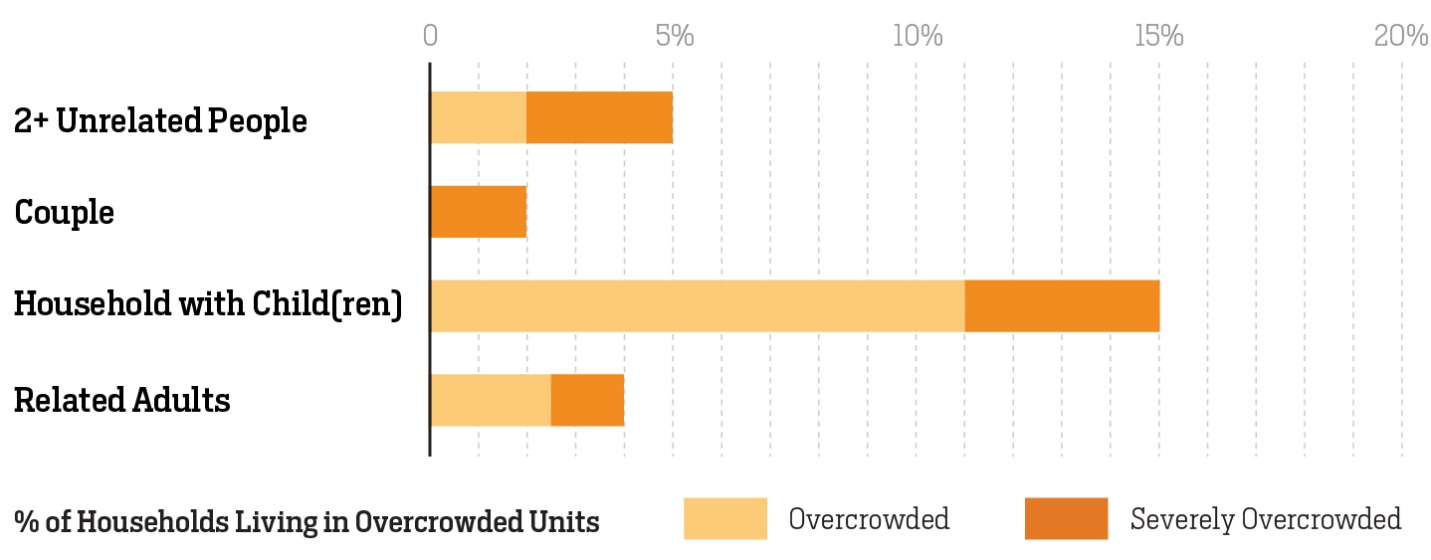
Figure 29. Percentage of households living in overcrowded* units by household type (2015).
* Overcrowded conditions are defined as more than one person per room, including the living room.
Source: San Francisco Housing Needs and Trends Report. Data: ACS 2015 5-year Estimates.
25. This funding source is for the general fund and is subject to annual appropriation. For FY20-21, $10M of supplemental appropriation was approved for affordable housing.
26. San Francisco is the third city in the world with the highest concentration of billionaires Source and the Bay Area has concentrated around 20 percent of global venture capital, half of ‘unicorn’ companies and 8 out of 13 valued over $10 billion.
27. Co-housing, group housing, or co-living rooms are a type of housing that may have limited cooking facilities and do not contain a full kitchen in each room. Co-housing may include (but is not limited to) communes, fraternities and sororities, or Residential Hotels.
Goal 5. Promote neighborhoods that are well-connected, healthy, and rich with community culture.
Challenge - San Francisco’s neighborhoods have unique qualities and histories that enrich their residents and communities, but they also are the result of incremental decision-making and discriminatory practices that have left disparities in public services, resources, and impacts from environmental damage. Government agencies have sometimes organized past public investment around the location of new housing or land-use changes rather than an accounting for equity, which may consider needs, and quality of public investments.
Additionally, private enterprise that supports essential services like healthy food, healthcare, laundry, or childcare, has become increasingly pushed to serve high earners as their economic margins have dropped, even prior to the pandemic. Small businesses provide some of these essential services in addition to serving as neighborhood centers. However, according to the California Employment Development Department, the number of retail establishments with fewer than 10 employees in San Francisco dropped over 8%, between 2007 and 2017. As land values and online shopping and delivery services have increased and brick-and-mortar retail declined, the health of neighborhood commercial corridors varied with some corridors struggling, reducing residents’ access to nearby services and opportunities to support community culture and cohesion.
Path Forward - Having a safe, sustainable, nurturing home means more than inhabiting an indoor structure, it must be in and connected to a larger place that fulfills residents’ social, cultural, and physical growth. For a neighborhood to house people, it must provide access to good quality grocery stores, healthcare, schools, community services, arts, and cultural institutions. It must create a healthy environment with clean air, water, and soil and be prepared for the heightened impacts of the climate crisis, especially protecting those most at-risk. It must connect us to areas and resources beyond the neighborhood and across the city and region through equitable transit and transportation infrastructure. While a set of amenities may not be the same across neighborhoods, the City should support the unique ecosystem of each one that will nourish its communities and center equity in government investments.
This Goal provides a solid framework for the allocation of resources where changes are more urgent. To achieve healthy neighborhoods for housing residents, the City must focus on repairing past harms through environmental justice and equitable mobility strategies to address the disparate outcomes in wealth and health in Priority Equity Geographies while protecting these communities against displacement.
At the same time, as San Francisco population grows the existing community facilities and services, including parks, schools, libraries, police, and fire departments, must address the growing need. Recent neighborhood zoning changes have included planning for infrastructure such as transit, open space, and street improvements using development impact fees to help fund such infrastructure, such as the Southeast Framework and Greater SoMa Community Facilities Needs Assessment (see Figures 30 to 32).
Housing in a neighborhood can foster relationships, identities, creativity, and individual well-being. Neighborhoods that express individual personalities and shared connections across cultures, race, and ethnicity, or art and architectural heritage provide a sense of community. Considering housing proximity and access to goods and services can reduce burdens, enhance the experience, or encourage healthy habits in daily life. Each neighborhood is a result of its people and histories and their efforts and challenges and should reflect these specific experiences, undo past harms, and adapt to changing conditions.
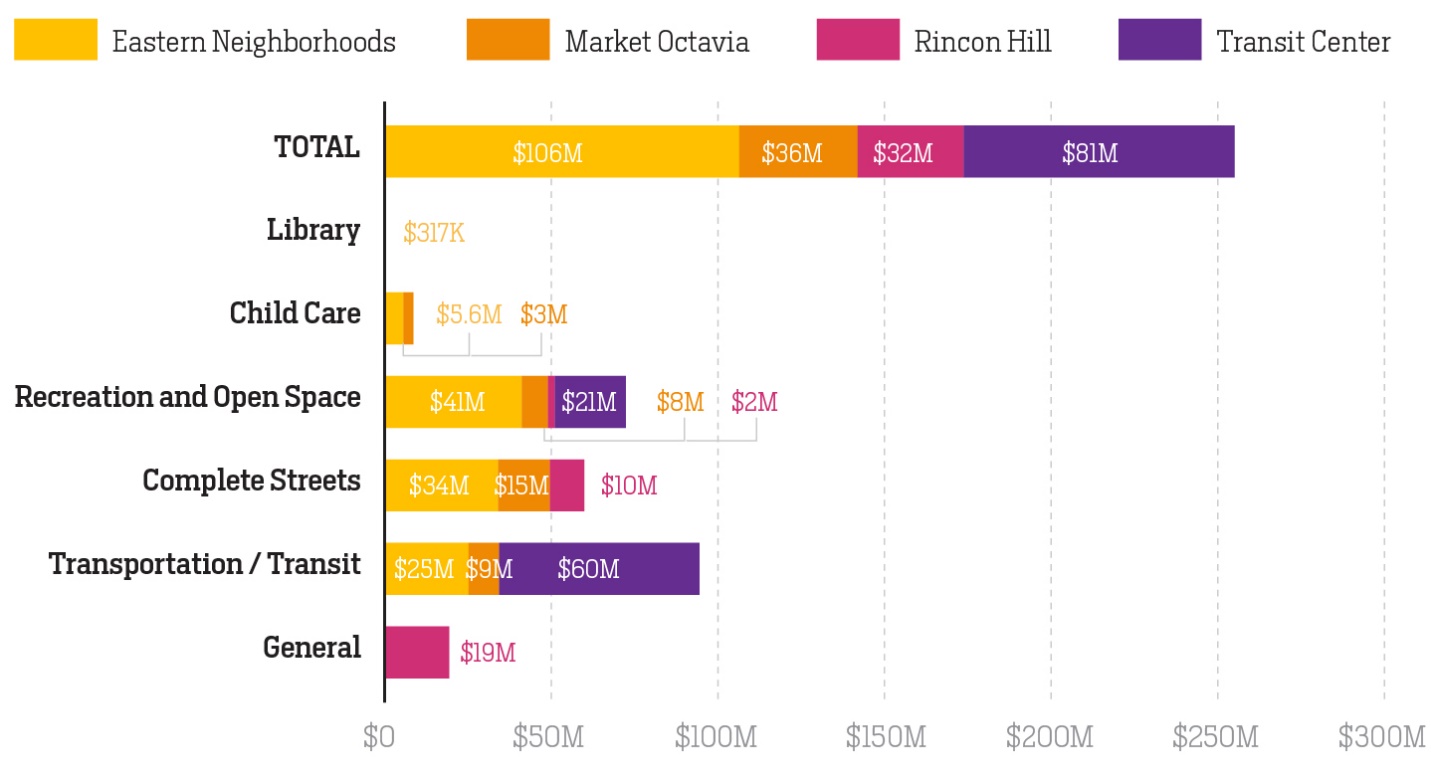
Figure 30. Infrastructure impact fees generated from development in Area Plans.
Source: SF Planning and DBI.

Figure 31. Nearly half of the cost of In Chan Kaajal Park, a park built in 2017 in the Mission, was funded by development impact fees.
Photo: San Francisco Recreation & Parks

Figure 32. Streetscape improvements along 22nd street to improve pedestrian safety was largely funded by development impact fees.
Rendering: San Francisco Public Works
OBJECTIVE 5.A
Connect people to jobs and their neighborhood with numerous, equitable, and healthy transportation and mobility options
Challenge - As the city and region have developed through decades of changes in economic, living, and land use patterns, transportation infrastructure has often been deployed to reconnect people’s needs, primarily around jobs and housing. However, local governmental agencies often focused on the needs of middle- and high-income workers (e.g., freeways, regional commuter transit) and left many populations, especially those of color or with low-wage jobs or those outside the workforce or with other needs, with few or burdensome options. For example, Golden Gate Park, with its world-class cultural institutions and well-maintained open space full of programs and activities, is an hour-long bus ride from the areas in the city with the highest percentage of children, including Bayview, Outer Mission, and the Excelsior.
It has become increasingly difficult and more expensive to complete new infrastructure projects, including transportation projects. Thus, the City is challenged to keep up with growth, which, limits persons quality and life and access to opportunities (e.g., jobs, parks, schools, etc.). Those living in historically underserved communities and those with limited mobility options continue to face greater challenges than those able-bodied persons with more resources.
Additionally, the past two decades have transformed former mostly industrial neighborhoods into more mixed-use neighborhoods, including with housing. This has occurred primarily in the southeast portion of the city where historically there was less investment and stability in the types of small businesses that serve residents. These redeveloping areas include public benefits such as new or improved infrastructure. However, some residents may feel some benefits are oriented to future residents rather than supporting the needs of existing residents and businesses.
Path Forward - A more equitable San Francisco requires planning for how housing, jobs, services, institutions, and resources are interconnected in and between vibrant neighborhoods.
Some areas of the city, primarily lower density neighborhoods in the middle, western, and northern neighborhoods, have had greater per capital public investment in infrastructure This includes more per capita investments in schools, transit, parks, and other community facilities. Providing more housing in these locations opens access to these benefits to more people. The City will address how new housing impacts existing neighborhoods depending on their geography, history, cultural identity, and past discrimination. These efforts address and support neighborhood life, such as economic development, facility planning, collaboration across agencies, and community-based organizations. The priority is to help people thrive by meeting their needs and providing opportunities that are easily accessible, which also supports San Francisco’s goals for of healthier transportation and climate.
San Francisco has been a Transit First City for 45+ years, with a clear intention of supporting public transportation and walkable and bikeable neighborhoods. In the past decade, it has also significantly invested in Vision Zero, a program to get to zero traffic fatalities by 2024; the Climate Action Plan 2021, to reduce carbon emissions; and ConnectSF a fifty-year vision for San Francisco’s mobility. ConnectSF relates directly to housing considerations, for example that we should preserve permanently affordable housing. Maintaining – and increasing – the City’s stock of permanently affordable housing is critical, especially in areas receiving new infrastructure investment and add new low- and moderate-income housing near essential services and schools. The city’s transportation policies will also be anchored in the upcoming Transportation Element Update which will be designed to center racial and social equity to redress historic harms, prioritize undoing damage, promote equity, and prioritize those most at-risk of being excluded from transportation resources.
One of the City’s climate goals is to have 80% of trips be made using low carbon modes by 2030 – such as transit, walking, biking, or electric vehicle. Building multi-family housing near transit helps the City meet these goals. It helps the City meet climate goals by providing access to transit for more people; it improves the cost-effectiveness of existing transit investments and makes the City more competitive for regional, state, and federal funds to expand transit; and it provides a larger customer base for businesses located along or nearby transit lines.
OBJECTIVE 5.B
Advance environmental justice, climate, and community resilience
Challenge – Many environmental perils exist for residents of San Francisco, some natural and others exacerbated by human action, resulting in inequitable consequences. In San Francisco, as in many other cities, low-income households and people of color are more likely to live in neighborhoods with environmental hazards, such as toxic groundwater, polluting industrial activities, congested freeways, and hazardous and solid waste facilities. In large part, this is the direct result of racial covenants, redlining, urban renewal and other discriminatory programs that have historically restricted where people of color may live. Furthermore, these communities may be less likely to have access to health-supportive resources, such as grocery stores, safe parks and open spaces, adequate and stable employment, health facilities, and frequent public transit. These disparities result in worse health outcomes and shortened life expectancy for our most vulnerable populations. For instance, in San Francisco, the average life expectancy for Black men (68 years) is more than a decade shorter than the citywide average (80 years), and 15 years shorter than the group with the longest life expectancy, Asian men (83 years).28
The COVID-19 pandemic has exacerbated the consequences of these existing health disparities. To date, the pandemic has disproportionately impacted communities of color, with those in the Latino/e/x and Black communities at highest risk (see Figure 33). The same health conditions that are more prevalent in neighborhoods most impacted by environmental injustice – asthma, heart disease, diabetes, hypertension – have also been identified as major risk factors for COVID-19.
San Francisco is increasingly vulnerable to climate crisis-related hazards like sea level rise, poor air quality, and extreme heat events. For example, approximately 37,200 people in San Francisco live in areas vulnerable to flooding from sea level rise (see Figure 34) and recent wildfires have shown that the entire city is vulnerable to poor air quality. Environmental pollution also affects certain neighborhoods that are identified by the State as “disadvantaged communities.”29 Similarly, earthquakes have been a historic hazard to San Francisco residents despite the city having the highest building code rating for structural safety required in new buildings. The city has had programs that require or encourage seismic upgrades to existing buildings, with the aim of fostering a housing stock resilient to possible future earthquakes. This continues to be a challenge, along with the possible massive disruptions to infrastructure.
Even under normal conditions, housing is in constant need of repair and rehabilitation to remain safe and supportive. Those who have housing instability are more likely to stay in housing that is unsafe or inadequate where either landlords or low-income homeowners defer improvements, with the latter facing increasing pressure to sell and leave the city altogether. Or in cases where the housing is maintained, households may have a higher occupancy than is safe, rendering fire codes insufficient in case of emergency.
Path Forward - Addressing both safe housing and a safe environment for neighborhoods requires substantial investment, planning, and inter-agency coordination. The City’s Climate Action Plan 2021, Earthquake Safety Implementation Program, and the Environmental Justice Framework (see Figure 35) currently in process are three significant efforts across the city to address the many environmental challenges in relation to housing. In 2019, San Francisco declared a climate emergency in accordance with the Paris Climate Agreement and committed to eliminating greenhouse gas emissions by 2050. This commitment relies on the transformation of energy supply, buildings, transportation, and waste system to reduce emissions. New housing development can help contribute to these goals by meeting the City’s Green Building Code standards. Emissions from buildings stem mostly from the use of natural gas for water and from space heating, recently eliminated as an option through the City’s New Construction Ordinance. San Francisco has committed to zero emissions in new construction by no later than 2030.
As most of San Francisco’s housing was built before the middle of the last century, many buildings may require upgrades to improve resiliency against these hazards as well as general habitability. Older and inadequately maintained buildings are less able to weather the impacts of these climate and environmental challenges. When these buildings fail, the outcomes are worse for lower-income households and those with health conditions and other existing vulnerabilities. As local, state, and federal resources are made available to address efficiency and resiliency of residential buildings, for example the State-funded and locally run CALHome program, and the Capital Improvement Program, these resources should be prioritized to address existing inequities faced in vulnerable neighborhoods. The city should continue to support seismic upgrades and lead remediation, in such programs as DPH’s Childhood Prevention Lead Program, prioritizing homeowners in Environmental Justice communities.
New housing development can also include neighborhood retail and other services on the ground floor, such as grocery stores, childcare, stores, restaurants, community centers, health facilities, etc. that meet the needs of residents. Finally, new housing can provide open space as required by SF Planning Code, community gardens, living roofs as required by the SF Better Roofs Ordinance (see Figure 36), and street trees as required by the SF Better Streets Plan that benefit existing and new neighbors. Integrating and designing sites to accommodate nature, through requirements such as Bird Safe Building Standards, throughout our streets and buildings improves air quality, plant and wildlife health, human wellness, and climate adaptation.
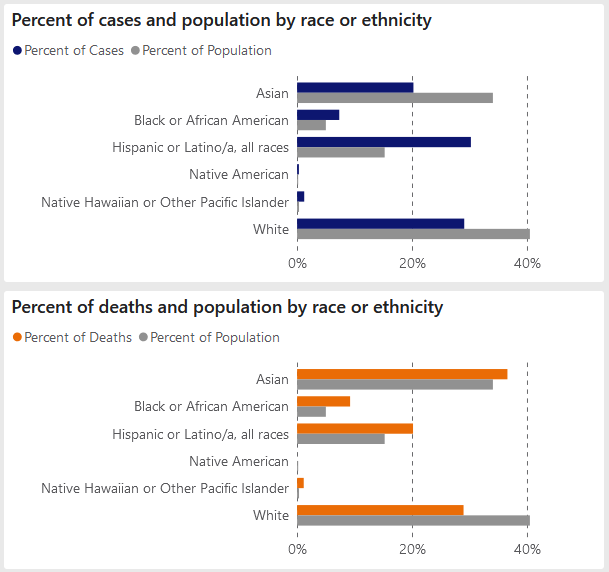
Figure 33. Percent of cases and death by race or ethnicity.
Source: Data SF; extracted January 14, 2022.

Figure 34. Areas vulnerable to sea level rise.
Source: San Francisco Sea Level Rise Action Plan
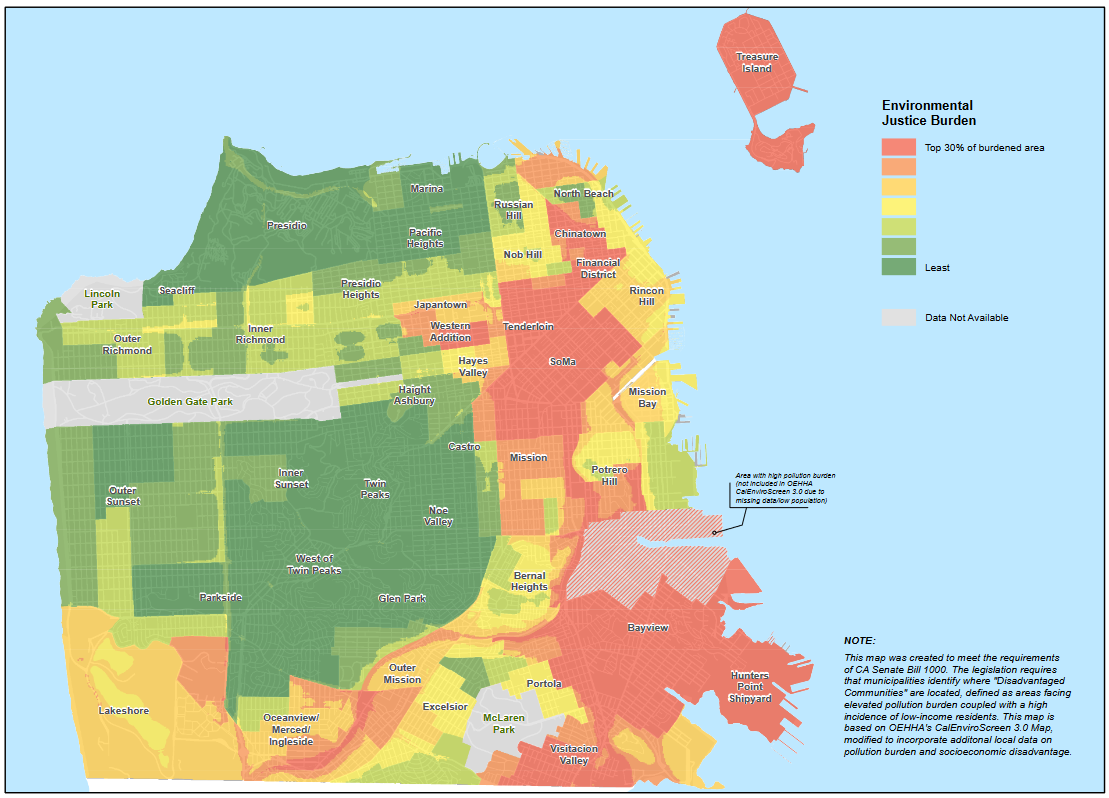
Figure 35. Draft Environmental Justice Communities (2021).
Areas of San Francisco that have higher pollution and are predominately low-income. This map is based on CalEnviroScreen, a tool created by CalEPA & OEHHA that maps California communities that are most affected by pollution and other health risks. “EJ Communities” are defined as the census tracts with the top 30% of cumulative environmental and socioeconomic vulnerability across the city.
Source: SF Planning’s Environmental Justice Framework.
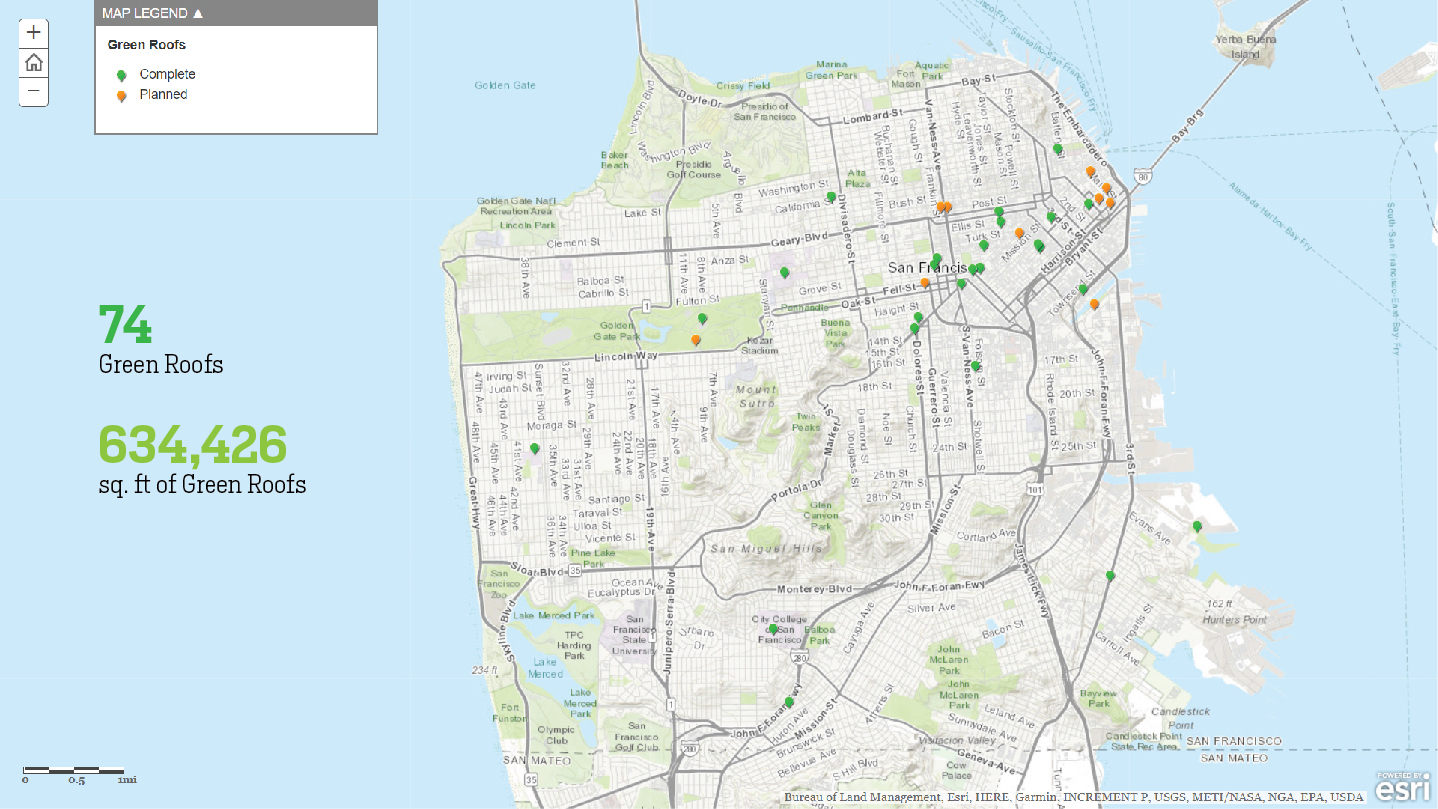
Figure 36. San Francisco has recently required certain development projects to provide a 'living roof'.
Source: San Francisco Planning
OBJECTIVE 5.C
Elevate expression of cultural identities through the design of active and engaging neighborhood buildings and spaces
Policy 12 Policy 37 Policy 41 Policy 42
Challenge - The cultural diversity of San Francisco’s neighborhoods is threatened by the displacement of racial, ethnic, and other marginalized cultural groups, such as transgender and LGBTQ+ residents. While San Francisco’s neighborhoods still retain a high level of cultural identity which contributes to their sense of place and to the residents’ sense of belonging, this aspect of community stability is hard to sustain when the culture bearers and community members that embody that identity can no longer afford to live in the neighborhood. Across communities of color and other marginalized groups, the forces of displacement are making it difficult for cultural groups to transmit the traditions, practices, and artistic expressions that define them and their heritage. This erodes the health and cultural richness of the community, which can be witnessed through the loss of culturally significant businesses, community spaces, art, and cultural programming.
As an example of this challenge to retain the city’s cultural diversity, the city has lost significant Legacy Businesses30 over the past decade due to displacement pressures and lower income communities of color have been hit particularly hard. A 2014 report by the City’s Budget and Legislative Analyst’s Office showed the closure of small businesses in San Francisco had reached record numbers with almost 4,000 small businesses closing in 2014 alone. In contrast, only 693 small businesses closed in 1994, the first year of the study. The report drew connections to San Francisco’s skyrocketing rents and the high level of commercial evictions, which continue today. The Legacy Business Registry and corresponding fund were created in 2015 in recognition of this loss and to mitigate or reverse the trend.
Similarly, the city’s Cultural Districts Initiative was formalized in 2018 with the aim of stabilizing vulnerable communities facing or at risk of displacement or gentrification, and to preserve, strengthen and promote our cultural assets and diverse communities. While both of these innovative programs provide potentially effective models for government interventions to fight community displacement and elevate expressions of cultural identity, the funding needs of both programs to date have far exceeded the allocated resources.
While many parts of the city, such as the Cultural Districts, aim to reinforce cultural identities that are at-risk, other parts of the city not identified as such may expect new housing opportunities to arrive subject to more general design guidance. Historically, San Francisco design guidance has reinforced existing patterns, whether in massing or façade or roofline expression, even though some of the original housing stock was mass-produced with little individual character or architectural quality. While this desire for compatibility was intended to prevent vast and dramatic changes in scale, in practice over time scale has mostly been addressed through code or zoning requirements and these have mostly limited creativity, architectural expression, and muted the voices of an expanding diversity of residents. While continuity of place is essential in cities, public space, facades, and street environments should also reflect the evolutions in personal and cultural expression.
Path Forward - As new development comes to San Francisco’s neighborhoods, good building design should remain sensitive to the unique neighborhood context while enhancing these neighborhoods. New buildings can improve the experience of existing and new neighbors through architecture, services or retail provided on the ground floor, or the streetscape improvements on the fronting street. New development should help maintain neighborhoods’ historic architectural heritage and landmarks as well as their cultural heritage: objects, beliefs, traditions, practices, artistic interpretation, and significant places that develop a sense of belonging and identity. New development must also recognize the erased histories and heritage from American Indian, Black, and other communities of color.
Cultural Districts will be an important platform to move forward; they have been defined by the city as areas containing a concentration of cultural and historic assets, culturally significant enterprise, arts, services, or businesses and a significant portion of its residents or people who spend time in the area, are members of a specific cultural community or ethnic group that historically has been discriminated against, displaced or oppressed. By reflecting the cultural identities of their residents in new development, building design can create environments that cultivate understanding and appreciation of diverse peoples, that honor the stories of all communities, and that foster a sense of belonging for all residents. This can be achieved through design and artistic expression in the built environment – buildings, parks, sidewalks, streets, structures, and other public spaces – and through the activation and use of public and private spaces. By elevating expression of cultural identities, the City can encourage more equitable local economies, and advance social justice. In this way, this objective also furthers Objective 3a to “Build intergenerational wealth for American Indian, Black, and other communities of color.” The creativity and sense of belonging resulting from this work will promote mental health while resulting in layered cultural landscapes and experiences for residents, workers, and visitors.
Achieving this objective will mean re-evaluating how existing and new design guidelines can be utilized to foster creativity while implementing foundational design principals and ensuring durable building materials. It also requires the Planning Department to explore how design, especially at the ground floor, supports social engagement and the vibrancy of neighborhoods. At the same time, it requires tools that ensure that existing expressions of cultural identity and places that hold cultural and historic meaning are respected. In other cases, the city should explore limiting or revising discretionary guidelines to balance the needs of new housing and neighborhood scale, which is already governed by definitive height and bulk controls. By creating and adopting objective standards that focus on the major concerns—light and air, dramatic shifts in scale— the city can allow for more flexibility in how neighborhoods look and feel, inviting new residents to join in and creative disciplines to deploy their talents.
The management of culturally and historically significant spaces must be guided by the culture bearers and descendants of those cultural groups, and special attention should be paid to those groups that have been marginalized from these decisions in the past. Ramaytush descendants and the American Indian community more broadly both hold special roles in guiding how the city manages tribal cultural resources and places significant for American Indian cultural practices. Consultation methods and information systems must be improved to ensure their full participation in decisions affecting the Ramaytush and American Indian community.
The City can utilize and expand existing historic preservation tools such as protective ordinances, rehabilitation incentives, and environmental laws to improve the management of places that express cultural identity. And the City can grow new and innovative programs such as the Legacy Business Registry, the Citywide Retail Strategy, and Cultural District program to guide cultural resource management and programs intended to support cultural uses and activities throughout the city.
28. “Mortality.” SFHIP. San Francisco Health Improvement Partnership. Accessed January 14, 2022. http://www.sfhip.org/chna/community-health-data/mortality/
29. “Disadvantaged communities” is an area identified by the California Environmental Protection Agency pursuant to Section 39711 of the Health and Safety Code or an area that is a low-income area that is disproportionately affected by environmental pollution and other hazards that can lead to negative health effects, exposure, or environmental degradation.” Source: CA Office of Planning and Research, General Plan Guidelines, Chapter 4: Required Elements, June 2020
30. In order to be designated by the Board of Supervisors as a Legacy Business, businesses must generally have operated in San Francisco for 30 or more years, have contributed to the city’s history and/or the identity of a particular neighborhood or community, and be committed to maintaining the physical features and traditions that define the business, including crafts, cuisines, art forms, or activities.
POLICIES
POLICY 1
Minimize no-fault and at-fault evictions for all tenants, and expand direct rental assistance as a renter stabilization strategy.
Related Objectives
OBJECTIVE 1.A
ENSURE HOUSING STABILITY AND HEALTHY HOMES.
OBJECTIVE 1.B
ADVANCE EQUITABLE HOUSING ACCESS.
OBJECTIVE 3.C
ELIMINATE COMMUNITY DISPLACEMENT WITHIN AREAS VULNERABLE TO DISPLACEMENT.
Implementing Program Areas
1 Affordable Housing Resources and Equitable Access
1.5 Deep Affordability and Rent Assistance for Lowest Income Renters
2 Stabilizing Tenants and Rental Housing
2.1 Eviction Prevention and Anti-displacement;
2.2 Tenant Protections
3 Preventing and Eliminating Homelessness
3.2 Problem Solving and Targeted Homelessness Prevention
POLICY 2
Preserve affordability of existing subsidized housing, government-owned or cooperative-owned housing, or SRO hotel rooms where the affordability requirements are at risk or soon to expire.
Related Objectives
OBJECTIVE 1.A
ENSURE HOUSING STABILITY AND HEALTHY HOMES.
OBJECTIVE 1.B
ADVANCE EQUITABLE HOUSING ACCESS.
OBJECTIVE 3.C
ELIMINATE COMMUNITY DISPLACEMENT WITHIN AREAS VULNERABLE TO DISPLACEMENT.
POLICY 3
Acquire and rehabilitate privately-owned housing as permanently affordable to better serve residents and areas vulnerable to displacement with unmet affordable housing needs.
Related Objectives
OBJECTIVE 1.A
ENSURE HOUSING STABILITY AND HEALTHY HOMES.
OBJECTIVE 1.B
ADVANCE EQUITABLE HOUSING ACCESS.
OBJECTIVE 4.A
SUBSTANTIALLY EXPAND THE AMOUNT OF PERMANENTLY AFFORDABLE HOUSING FOR EXTREMELY LOW- TO MODERATE-INCOME HOUSEHOLDS.
Implementing Program Areas
2 Stabilizing Tenants and Rental Housing
2.3 Acquisitions and Rehabilitation for Affordability
POLICY 4
Facilitate the legalization of unauthorized dwelling units while improving their safety and habitability.
Related Objectives
OBJECTIVE 4.B
EXPAND SMALL AND MID-RISE MULTI-FAMILY HOUSING PRODUCTION TO SERVE OUR WORKFORCE, PRIORITIZING MIDDLE-INCOME HOUSEHOLDS.
Implementing Program Areas
2 Stabilizing Tenants and Rental Housing
2.4 Preserving Rental Unit Availability
POLICY 5
Improve access to the available Affordable Rental and Homeownership units especially for disproportionately underserved racial and social groups.
Related Objectives
OBJECTIVE 1.B
ADVANCE EQUITABLE HOUSING ACCESS.
OBJECTIVE 3.A
BUILD INTERGENERATIONAL WEALTH FOR AMERICAN INDIAN, BLACK, AND OTHER COMMUNITIES OF COLOR.
POLICY 6
Advance equal housing access by eliminating discrimination based on race, ethnicity, immigration status, HIV+ status, gender identity, sexual orientation, disabilities, age, prior incarceration, or mental health and improving housing programs for underserved groups.
Implementing Program Areas
1 Affordable Housing Resources and Equitable Access
1.7 Eligibility and Access for Affordable Housing
3 Preventing and Eliminating Homelessness
3.1 Coordinated Entry and Referrals
5 Redressing and Preventing Discrimination
5.3 Fair Housing Compliance and Enforcement
6 Serving Special Needs Groups
6.3 Seniors and People with Disabilities and Chronic Illness
POLICY 7
Pursue permanently affordable housing investments that are specific to the geographic, cultural, and support needs of recently arrived or newly independent residents or residents from marginalized groups, including transgender and LGBTQ+ people.
Related Objectives
OBJECTIVE 1.B
ADVANCE EQUITABLE HOUSING ACCESS.
OBJECTIVE 4.C
DIVERSIFY HOUSING TYPES FOR ALL CULTURES, FAMILY STRUCTURES, AND ABILITIES.
POLICY 8
Expand permanently supportive housing and services for individuals and families experiencing homelessness as a primary part of a comprehensive strategy to eliminate homelessness.
Related Objectives
OBJECTIVE 1.C
ELIMINATE HOMELESSNESS.
OBJECTIVE 4.A
SUBSTANTIALLY EXPAND THE AMOUNT OF PERMANENTLY AFFORDABLE HOUSING FOR EXTREMELY LOW- TO MODERATE-INCOME HOUSEHOLDS.
Implementing Program Areas
3 Preventing and Eliminating Homelessness
3.1 Coordinated Entry and Referrals;
3.3 Temporary Shelter;
3.4 Supportive Housing
5 Redressing and Preventing Discrimination
5.3 Fair Housing Compliance and Enforcement
6 Serving Special Needs Groups
6.2 Transgender and LGBTQ+ People
POLICY 9
Prevent homelessness and eviction through comprehensive evidence-based systems, including housing and other services targeted to serve those at risk of becoming unhoused31.
Related Objectives
OBJECTIVE 1.A
ENSURE HOUSING STABILITY AND HEALTHY HOMES.
OBJECTIVE 1.B
ADVANCE EQUITABLE HOUSING ACCESS.
OBJECTIVE 1.C
ELIMINATE HOMELESSNESS.
Implementing Program Areas
1 Affordable Housing Resources and Equitable Access
1.5 Deep Affordability and Rent Assistance for Lowest Income Renters
2 Stabilizing Tenants and Rental Housing
2.1 Eviction Prevention and Anti-displacement
3 Preventing and Eliminating Homelessness
3.1 Coordinated Entry and Referrals;
3.2 Problem Solving and Targeted Homelessness Prevention;
3.3 Temporary Shelter;
3.4 Supportive Housing
6 Serving Special Needs Groups
6.2 Transgender and LGBTQ+ People
POLICY 10
Acknowledge the truth about discriminatory practices and government actions32 as told by American Indian, Black, and other communities of color to understand the root causes of the housing disparities in these communities and to inform how to redress the harms.
Implementing Program Areas
5 Redressing and Preventing Discrimination
5.1 Truth-telling and Acknowledging Past Harm
POLICY 11
Establish and sustain homeownership programs and expand affordable housing access for American Indian, Black, Japanese, Filipino, and other communities to redress harm directly caused by past discriminatory government actions including redlining, urban renewal, the Indian Relocation Act, or WWII Japanese incarceration.
Related Objectives
OBJECTIVE 2.B
OFFER REPARATIONS FOR COMMUNITIES DIRECTLY HARMED BY PAST DISCRIMINATORY GOVERNMENT ACTION AND BRING BACK THEIR DISPLACED PEOPLE.
OBJECTIVE 3.A
BUILD INTERGENERATIONAL WEALTH FOR AMERICAN INDIAN, BLACK, AND OTHER COMMUNITIES OF COLOR.
OBJECTIVE 3.C
ELIMINATE COMMUNITY DISPLACEMENT WITHIN AREAS VULNERABLE TO DISPLACEMENT.GOVERNMENT ACTION AND BRING BACK THEIR DISPLACED PEOPLE.
Implementing Program Areas
5 Redressing and Preventing Discrimination
5.4 Housing Programs to Redress Harm
POLICY 12
Invest in and expand access to cultural anchors, land, and spaces that are significant to American Indian, Black, Japanese, Filipino, and other communities directly harmed by past discriminatory government actions including redlining, urban renewal, the Indian Relocation Act or WWII Japanese incarceration to redress histories of dispossession, social disruption, and physical displacement.
Related Objectives
OBJECTIVE 2.B
OFFER REPARATIONS FOR COMMUNITIES DIRECTLY HARMED BY PAST DISCRIMINATORY GOVERNMENT ACTION AND BRING BACK THEIR DISPLACED PEOPLE.
OBJECTIVE 3.A
BUILD INTERGENERATIONAL WEALTH FOR AMERICAN INDIAN, BLACK, AND OTHER COMMUNITIES OF COLOR.
OBJECTIVE 5.C
ELEVATE EXPRESSION OF CULTURAL IDENTITIES THROUGH THE DESIGN OF ACTIVE AND ENGAGING NEIGHBORHOOD BUILDINGS AND SPACES.
POLICY 13
Amplify and prioritize voices of American Indian, Black, and other people of color, and other disadvantaged communities, and embrace the guidance of their leaders throughout the engagement and planning processes for housing policy, planning, programs, and developments.
Related Objectives
OBJECTIVE 2.C
INCREASE ACCOUNTABILITY TO AMERICAN INDIAN, BLACK, AND OTHER COMMUNITIES OF COLOR.
POLICY 14
Establish accountability tools to advance racial and social equity in housing access with measurable progress.
Related Objectives
OBJECTIVE 2.C
INCREASE ACCOUNTABILITY TO AMERICAN INDIAN, BLACK, AND OTHER COMMUNITIES OF COLOR.
POLICY 15
Expand permanently affordable housing investments in Priority Equity Geographies to better serve American Indian, Black, and other People of color within income ranges underserved, including extremely-, very low-, and moderate-income households.
Related Objectives
OBJECTIVE 3.A
BUILD INTERGENERATIONAL WEALTH FOR AMERICAN INDIAN, BLACK, AND OTHER COMMUNITIES OF COLOR.
OBJECTIVE 4.A
SUBSTANTIALLY EXPAND THE AMOUNT OF PERMANENTLY AFFORDABLE HOUSING FOR EXTREMELY LOW- TO MODERATE-INCOME HOUSEHOLDS.
Implementing Program Areas
1 Affordable Housing Resources and Equitable Access
1.2 Affordable Housing Production;
1.4Affordable Housing Preservation;
1.5 Deep Affordability and Rent Assistance for Lowest Income Renters;
1.7 Eligibility and Access for Affordable Housing
4 Centering Equity Communities and Cultural Heritage
4.2 Community Planning
POLICY 16
Improve access to well-paid jobs and business ownership for American Indian, Black and other communities of color, particularly those who live in Priority Equity Geographies, to build the wealth needed to afford and meet their housing needs.
Related Objectives
OBJECTIVE 3.A
BUILD INTERGENERATIONAL WEALTH FOR AMERICAN INDIAN, BLACK, AND OTHER COMMUNITIES OF COLOR.
Implementing Program Areas
4 Centering Equity Communities and Cultural Heritage
4.3 Access to Economic Opportunity
POLICY 17
Expand investments in Priority Equity Geographies to advance equitable access to resources while ensuring community stability.
Related Objectives
OBJECTIVE 3.A
BUILD INTERGENERATIONAL WEALTH FOR AMERICAN INDIAN, BLACK, AND OTHER COMMUNITIES OF COLOR.
OBJECTIVE 5.A
CONNECT PEOPLE TO JOBS AND THEIR NEIGHBORHOOD WITH NUMEROUS, EQUITABLE, AND HEALTHY TRANSPORTATION AND MOBILITY OPTIONS.
POLICY 18
Tailor zoning changes within Priority Equity Geographies and intersecting Cultural Districts to serve the specific needs of American Indian, Black, and other communities of color while implementing programs to stabilize communities and meet community needs.
Related Objectives
OBJECTIVE 2.C
INCREASE ACCOUNTABILITY TO AMERICAN INDIAN, BLACK, AND OTHER COMMUNITIES OF COLOR.
OBJECTIVE 3.A
BUILD INTERGENERATIONAL WEALTH FOR AMERICAN INDIAN, BLACK, AND OTHER COMMUNITIES OF COLOR.
OBJECTIVE 3.C
ELIMINATE COMMUNITY DISPLACEMENT WITHIN AREAS VULNERABLE TO DISPLACEMENT.
Implementing Program Areas
4 Centering Equity Communities and Cultural Heritage
4.2 Community Planning
POLICY 19
Enable low and moderate-income households, particularly American Indian, Black, and other people of color, to live and prosper in Well-resourced Neighborhoods by increasing the number of permanently affordable housing units in those neighborhoods.
Related Objectives
OBJECTIVE 3.B
CREATE A SENSE OF BELONGING FOR ALL COMMUNITIES OF COLOR WITHIN WELL-RESOURCED NEIGHBORHOODS THROUGH EXPANDED HOUSING CHOICE.
OBJECTIVE 4.A
SUBSTANTIALLY EXPAND THE AMOUNT OF PERMANENTLY AFFORDABLE HOUSING FOR EXTREMELY LOW- TO MODERATE-INCOME HOUSEHOLDS.
POLICY 20
Increase mid-rise and small multi-family housing types by adopting zoning changes or density bonus programs in Well-resourced Neighborhoods and adjacent lower-density areas near transit, including along SFMTA Rapid Network33 and other transit.
Related Objectives
OBJECTIVE 3.B
CREATE A SENSE OF BELONGING FOR ALL COMMUNITIES OF COLOR WITHIN WELL-RESOURCED NEIGHBORHOODS THROUGH EXPANDED HOUSING CHOICE.
OBJECTIVE 4.B
EXPAND SMALL AND MID-RISE MULTI-FAMILY HOUSING PRODUCTION TO SERVE OUR WORKFORCE, PRIORITIZING MIDDLE-INCOME HOUSEHOLDS.
OBJECTIVE 5.A
CONNECT PEOPLE TO JOBS AND THEIR NEIGHBORHOOD WITH NUMEROUS, EQUITABLE, AND HEALTHY TRANSPORTATION AND MOBILITY OPTIONS.
POLICY 21
Prevent the potential displacement and adverse racial and social equity impacts of zoning changes, planning processes, or public and private investments especially for populations and areas vulnerable to displacement.
Related Objectives
OBJECTIVE 2.C
INCREASE ACCOUNTABILITY TO AMERICAN INDIAN, BLACK, AND OTHER COMMUNITIES OF COLOR.
OBJECTIVE 3.C
ELIMINATE COMMUNITY DISPLACEMENT WITHIN AREAS VULNERABLE TO DISPLACEMENT.
POLICY 22
Create dedicated and consistent local funding sources and advocate for regional, State, and Federal funding to support building permanently affordable housing for very low-, low-, and moderate-income households that meets the Regional Housing Needs Allocation targets.
Related Objectives
OBJECTIVE 1.C
ELIMINATE HOMELESSNESS.
OBJECTIVE 4.A
SUBSTANTIALLY EXPAND THE AMOUNT OF PERMANENTLY AFFORDABLE HOUSING FOR EXTREMELY LOW- TO MODERATE-INCOME HOUSEHOLDS.
POLICY 23
Retain and increase the number of moderate- and middle-income households by increasing their homebuying opportunities and reversing the shortage in housing that is affordable to these households.
Related Objectives
OBJECTIVE 4.A
SUBSTANTIALLY EXPAND THE AMOUNT OF PERMANENTLY AFFORDABLE HOUSING FOR EXTREMELY LOW- TO MODERATE-INCOME HOUSEHOLDS.
Implementing Program Areas
1 Affordable Housing Resources and Equitable Access
1.6 Homeownership Support
POLICY 24
Enable mixed-income development projects to maximize the number of permanently affordable housing units constructed, in balance with delivering other permanent community benefits that advance racial and social equity.
Related Objectives
OBJECTIVE 4.A
SUBSTANTIALLY EXPAND THE AMOUNT OF PERMANENTLY AFFORDABLE HOUSING FOR EXTREMELY LOW- TO MODERATE-INCOME HOUSEHOLDS.
Implementing Program Areas
1 Affordable Housing Resources and Equitable Access
1.2 Affordable Housing Production;
1.3 Inclusionary Housing
7 Expanding Housing Choices
7.3 Housing Near Job Centers and Transit
8 Reducing Constraints on Housing Development, Maintenance, and Improvement
8.4 Process and Permit Procedures;
8.7 Facilitating Large Projects;
8.9 Post-Entitlement Permitting and Pipeline Support
POLICY 25
Reduce governmental constraints on development in Well-resourced Neighborhoods to enable small and mid-rise multi-family buildings providing improved housing choice and affordability.
Related Objectives
OBJECTIVE 4.B
EXPAND SMALL AND MID-RISE MULTI-FAMILY HOUSING PRODUCTION TO SERVE OUR WORKFORCE, PRIORITIZING MIDDLE-INCOME HOUSEHOLDS.
Implementing Program Areas
8 Reducing Constraints on Housing Development, Maintenance, and Improvement
8.4 Process and Permit Procedures
POLICY 26
Streamline and simplify permit processes to provide more equitable access to the application process, improve certainty of outcomes, and ensure meeting State- and local-required timelines, especially for 100% affordable housing and shelter projects.
Related Objectives
OBJECTIVE 4.A
SUBSTANTIALLY EXPAND THE AMOUNT OF PERMANENTLY AFFORDABLE HOUSING FOR EXTREMELY LOW- TO MODERATE-INCOME HOUSEHOLDS.
OBJECTIVE 4.B
EXPAND SMALL AND MID-RISE MULTI-FAMILY HOUSING PRODUCTION TO SERVE OUR WORKFORCE, PRIORITIZING MIDDLE-INCOME HOUSEHOLDS.
Implementing Program Areas
3 Preventing and Eliminating Homelessness
3.3 Temporary Shelter
7 Expanding Housing Choices
7.2 Mid-rise and Small Multifamily Buildings;
7.3 Housing Near Job Centers and Transit
8 Reducing Constraints on Housing Development, Maintenance, and Improvement
8.1 Cost and Fees;
8.3 Objective Design Standards & Findings;
8.4 Process and Permit Procedures;
8.6 Support for Affordable and Supportive Housing and Shelters
9 Healthy, Connected, and Resilient Housing and Neighborhoods
9.4 Community Services
POLICY 27
Improve coordination, alignment, shared mission, and functionality of post-entitlement permit processes across agencies and jurisdictions to speed housing construction starts after approvals, especially for 100% affordable housing and development agreements.
Related Objectives
OBJECTIVE 4.A
SUBSTANTIALLY EXPAND THE AMOUNT OF PERMANENTLY AFFORDABLE HOUSING FOR EXTREMELY LOW- TO MODERATE-INCOME HOUSEHOLDS.
OBJECTIVE 4.B
EXPAND SMALL AND MID-RISE MULTI-FAMILY HOUSING PRODUCTION TO SERVE OUR WORKFORCE, PRIORITIZING MIDDLE-INCOME HOUSEHOLDS.
Implementing Program Areas
8 Reducing Constraints on Housing Development, Maintenance, and Improvement
8.1 Cost and Fees;
8.3 Objective Design Standards & Findings;
8.4 Process and Permit Procedures;
8.6 Support for Affordable and Supportive Housing and Shelters;
8.7 Facilitating Large Projects;
8.9 Post-Entitlement Permitting and Pipeline Support
POLICY 28
Affirm compliance in State housing law, requirements, and intent by strengthening data collection, clarifying definitions, and further supporting implementation.
Related Objectives
OBJECTIVE 4.A
SUBSTANTIALLY EXPAND THE AMOUNT OF PERMANENTLY AFFORDABLE HOUSING FOR EXTREMELY LOW- TO MODERATE-INCOME HOUSEHOLDS.
OBJECTIVE 4.B
EXPAND SMALL AND MID-RISE MULTI-FAMILY HOUSING PRODUCTION TO SERVE OUR WORKFORCE, PRIORITIZING MIDDLE-INCOME HOUSEHOLDS.
Implementing Program Areas
2 Stabilizing Tenants and Rental Housing
2.2 Tenant Protections
4 Centering Equity Communities and Cultural Heritage
4.2 Community Planning
8 Reducing Constraints on Housing Development, Maintenance, and Improvement
8.3 Objective Design Standards & Findings;
8.4 Process and Permit Procedures;
8.5 Compliance with State Programs and Law;
8.8 Policy and Practice Review;
8.9 Post-Entitlement Permitting and Pipeline Support
POLICY 29
Complete community-led processes in Priority Equity Geographies that provide defined community benefits or mitigations for effects of new development consistent with state and federal law in order to reduce burdens on advocates of vulnerable populations and community members and establish more predictable outcomes for housing applications.
Related Objectives
OBJECTIVE 2.C
INCREASE ACCOUNTABILITY TO AMERICAN INDIAN, BLACK, AND OTHER COMMUNITIES OF COLOR.
OBJECTIVE 3.B
CREATE A SENSE OF BELONGING FOR ALL COMMUNITIES OF COLOR WITHIN WELL-RESOURCED NEIGHBORHOODS THROUGH EXPANDED HOUSING CHOICE.
OBJECTIVE 3.C
ELIMINATE COMMUNITY DISPLACEMENT WITHIN AREAS VULNERABLE TO DISPLACEMENT.
OBJECTIVE 4.B
EXPAND SMALL AND MID-RISE MULTI-FAMILY HOUSING PRODUCTION TO SERVE OUR WORKFORCE, PRIORITIZING MIDDLE-INCOME HOUSEHOLDS.
POLICY 30
Support the reduction of non-governmental challenges that enable affordable housing and small and mid-rise multi-family buildings as a prominent housing type.
Related Objectives
OBJECTIVE 4.A
SUBSTANTIALLY EXPAND THE AMOUNT OF PERMANENTLY AFFORDABLE HOUSING FOR EXTREMELY LOW- TO MODERATE-INCOME HOUSEHOLDS.
OBJECTIVE 4.B
EXPAND SMALL AND MID-RISE MULTI-FAMILY HOUSING PRODUCTION TO SERVE OUR WORKFORCE, PRIORITIZING MIDDLE-INCOME HOUSEHOLDS.
POLICY 31
Facilitate small and mid-rise multi-family buildings that private development can deliver to serve middle-income households without deed restriction, including through adding units in lower density areas or by adding Accessory Dwelling Units (ADUs).
Related Objectives
OBJECTIVE 3.B
CREATE A SENSE OF BELONGING FOR ALL COMMUNITIES OF COLOR WITHIN WELL-RESOURCED NEIGHBORHOODS THROUGH EXPANDED HOUSING CHOICE.
OBJECTIVE 4.B
EXPAND SMALL AND MID-RISE MULTI-FAMILY HOUSING PRODUCTION TO SERVE OUR WORKFORCE, PRIORITIZING MIDDLE-INCOME HOUSEHOLDS.
POLICY 32
Promote and facilitate aging in place for seniors and multi-generational living that supports extended families and communal households.
Related Objectives
OBJECTIVE 4.C
DIVERSIFY HOUSING TYPES FOR ALL CULTURES, FAMILY STRUCTURES, AND ABILITIES.
POLICY 33
Prevent the outmigration of families with children and support the needs of families to grow.
Related Objectives
OBJECTIVE 4.C
DIVERSIFY HOUSING TYPES FOR ALL CULTURES, FAMILY STRUCTURES, AND ABILITIES.
POLICY 34
Encourage co-housing34 to support ways for households to share space, resources, and responsibilities, especially to reinforce supportive relationships within and across communities and generations.
Related Objectives
OBJECTIVE 4.C
DIVERSIFY HOUSING TYPES FOR ALL CULTURES, FAMILY STRUCTURES, AND ABILITIES.
POLICY 35
Require new commercial developments and large employers, hospitals, and educational institutions to help meet housing demand generated by anticipated job growth to maintain an appropriate jobs-housing fit, and address housing needs of students.
Related Objectives
OBJECTIVE 4.C
DIVERSIFY HOUSING TYPES FOR ALL CULTURES, FAMILY STRUCTURES, AND ABILITIES.
POLICY 36
Maximize the use of existing housing stock for residential use by discouraging vacancy, short-term use, and speculative resale.
Related Objectives
OBJECTIVE 4.C
DIVERSIFY HOUSING TYPES FOR ALL CULTURES, FAMILY STRUCTURES, AND ABILITIES.
Implementing Program Areas
2 Stabilizing Tenants and Rental Housing
2.4 Preserving Rental Unit Availability
POLICY 37
Facilitate neighborhoods where proximity to daily needs and high-quality community services and amenities promotes social connections, supports caregivers, reduces the need for private auto travel, and advances healthy activities.
Related Objectives
OBJECTIVE 5.A
CONNECT PEOPLE TO JOBS AND THEIR NEIGHBORHOOD WITH NUMEROUS, EQUITABLE, AND HEALTHY TRANSPORTATION AND MOBILITY OPTIONS.
OBJECTIVE 5.C
ELEVATE EXPRESSION OF CULTURAL IDENTITIES THROUGH THE DESIGN OF ACTIVE AND ENGAGING NEIGHBORHOOD BUILDINGS AND SPACES.
Implementing Program Areas
4 Centering Equity Communities and Cultural Heritage
4.3 Access to Economic Opportunity;
4.4 Cultural Districts;
4.5 Cultural Heritage and Expression
9 Healthy, Connected, and Resilient Housing and Neighborhoods
9.2 Resilient and Healthy Neighborhoods and New Housing;
9.3 Transportation;
9.4 Community Services
POLICY 38
Ensure transportation investments create equitable access to transit and are planned in parallel with increase in housing capacity to advance well-connected neighborhoods consistent with the City’s Connect SF vision, and encourage sustainable trips35 in new housing.
Related Objectives
OBJECTIVE 5.A
CONNECT PEOPLE TO JOBS AND THEIR NEIGHBORHOOD WITH NUMEROUS, EQUITABLE, AND HEALTHY TRANSPORTATION AND MOBILITY OPTIONS.
OBJECTIVE 5.B
ADVANCE ENVIRONMENTAL JUSTICE, CLIMATE, AND COMMUNITY RESILIENCE.
Implementing Program Areas
9 Healthy, Connected, and Resilient Housing and Neighborhoods
9.3 Transportation
POLICY 39
Support the repair and rehabilitation of housing to ensure life safety, health, and well-being of residents, especially in Environmental Justice Communities, and to support sustainable building practices.
Related Objectives
OBJECTIVE 1.A
ENSURE HOUSING STABILITY AND HEALTHY HOMES.
OBJECTIVE 5.B
ADVANCE ENVIRONMENTAL JUSTICE, CLIMATE, AND COMMUNITY RESILIENCE.
Implementing Program Areas
9 Healthy, Connected, and Resilient Housing and Neighborhoods
9.1 Housing Rehabilitation for Health and Safety
POLICY 40
Enforce and improve planning processes and building regulations to ensure a healthy environment for new housing developments, especially in Environmental Justice Communities.
Related Objectives
OBJECTIVE 1.A
ENSURE HOUSING STABILITY AND HEALTHY HOMES.
OBJECTIVE 5.B
ADVANCE ENVIRONMENTAL JUSTICE, CLIMATE, AND COMMUNITY RESILIENCE.
POLICY 41
Shape urban design policy, standards, and guidelines to enable cultural and identity expression, advance architectural creativity and durability, and foster neighborhood belonging.
Related Objectives
OBJECTIVE 5.C
ELEVATE EXPRESSION OF CULTURAL IDENTITIES THROUGH THE DESIGN OF ACTIVE AND ENGAGING NEIGHBORHOOD BUILDINGS AND SPACES.
POLICY 42
Support cultural uses, activities, and architecture that sustain San Francisco's diverse cultural heritage.
Related Objectives
OBJECTIVE 5.C
ELEVATE EXPRESSION OF CULTURAL IDENTITIES THROUGH THE DESIGN OF ACTIVE AND ENGAGING NEIGHBORHOOD BUILDINGS AND SPACES.
31. People with prior experience of homelessness, with involvement with the criminal justice, system, extremely-low and very-low income American Indian, Black, and Latino/es, domestic violence victims, transgender people, and those at imminent risk of losing housing (e.g., tenants with an eviction notice or subject to landlord harassment).
32. Discriminatory programs include, but are not limited to, redlining, urban renewal, segregated public housing, and exclusionary zoning regulations, such as single-family zoning.
33. The 13 rail and bus lines that account for the majority of Muni’s ridership. Before the pandemic, Rapid Network lines were scheduled to operate every 10 minutes or better all day on weekdays.
34. Co-housing, group housing, or co-living rooms are a type of housing that may have limited cooking facilities and do not contain a full kitchen in each room. Co-housing may include (but is not limited to) communes, fraternities and sororities, or Residential Hotels.
35. Sustainable trips utilize priority modes include walking, bicycling, transit, and vanpooling that have a low-carbon impact.
2022 Housing Element adopted by the Board of Supervisors Ordinance No. 0010-23 on 01/31/2023.

